
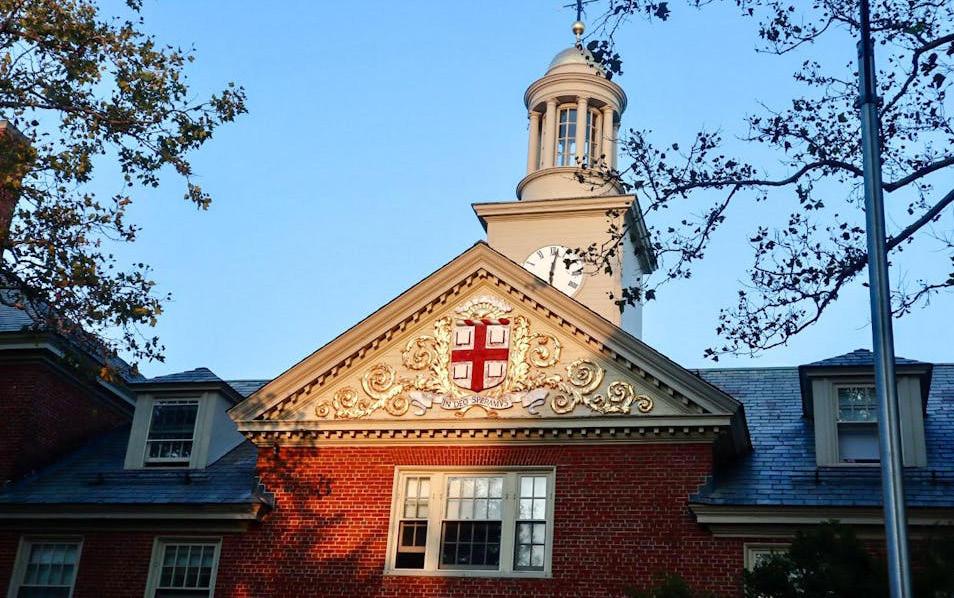
University
adds ‘fossil fuel-free’ option to faculty, staff retirement plans
LIL a QuINN / heraLd
The new offering — the Vanguard FTSE Social Index Admiral Fund — came in response to employee feedback and was celebrated by environmental activists.
New plan still includes 0.9% involvement in fossil fuels
BY ETHAN SCHENKER SENIOR STAFF WRITER
The university added a “fossil-free” mutual fund option to faculty and staff retirement plans in late december, benefits Operations director Kimberly almeida wrote in an email to The herald.
The new offering — the Vanguard FTse social Index Fund admiral — came in response to employee feedback, almeida wrote. The addition was celebrated by campus environmental activist group sunrise brown, which had been urging the university to include such a fund in its retirement plans.
The new fund still maintains ties to the fossil fuel industry, according to analyses of the mutual fund’s holdings by investment
CAMPUS REACTIONS
research firm Morningstar and the nonprofit group as you sow. but its involvement in fossil fuels is far lower than that of similar funds available to faculty and staff.
according to data from Morningstar, the new offering has a 0.91% involvement in fossil fuels, compared to a roughly 9.09% average involvement across all offerings. This average figure does not include money-market funds or fixed annuities.
The university’s retirement Planning Committee approved the modification in late september, according to an email obtained by The herald that Kurt Teichert, the chair of the advisory Committee on university resources Management, sent to student leaders of sunrise brown.
Other university retirement plans contain investments in several companies linked to fossil fuel extraction, including Chevron, ConocoPhillips and enbridge, The herald previously reported. at the time, faculty members told The herald that brown’s
Students respond to ADL CEO’s talk
Community members debate Greenblatt’s definition of antisemitism
BY KATE BUTTS SENIOR STAFF WRITER
Jonathan Greenblatt, the CeO of the anti-defamation League, spoke on campus Feb. 22 at an event sponsored by the Office of Institutional equity and diversity. Greenblatt’s visit, which saw dozens of students walk out during his talk, provoked discussion and controversy within the university community.
Greenblatt received both praise and criticism from students for his statements on antisemitism. In the past few months, he has stirred controversy for comments regarding students for Justice in Palestine — a national student movement with chapters at universities across the united states that has itself been criticized for
its political positions — and conflict in the Middle east, including his description of pro-Palestine student activist groups as “anti-Zionist extremists,” The herald previously reported.
Vice President for Institutional equity and d iversity sylvia Carey-butler said that Greenblatt “was invited to speak in september of ’23” in response to a series of antisemitic incidents that occurred on campus in 2022. Carey-butler added that she had reached out to the adL because it was “the largest organization” dedicated to fighting antisemitism, “not knowing anything about the current leadership.”
she emphasized that the invitation did not necessarily reflect her personal views or the OIed’s views, nor did it constitute an endorsement of Greenblatt.
The u niversity frequently invites guests with diverse political views to speak
retirement plans lacked environmentally sustainable investment options.
Faculty and staff can enroll in university-sponsored retirement plans through the Teachers Insurance and annuity association of america-College retirement equities Fund and Fidelity Investments. Faculty retirement plans previously offered only one sustainability-oriented fund option — the TIaa-CreF social equity Choice Fund.
“a socially responsible fund has always been available on the TIaa platform, and brown’s retirement Plan Committee wanted to offer comparable options through both carriers,” almeida wrote in an email to The herald.
but 8.5% of the TIaa-CreF equity social Choice fund’s holdings are tied to the fossil fuel industry, according to Morningstar. The limitations of a widely adopted environmental, social and Governance metric allowed TIaa to greenwash the fund — or promote it as environmentally friendly on
EVENTS
the surface — said adjunct Lecturer in environment and society Cary Krosinsky in a 2021 interview with The herald.
e-soo Kim, a member of the corporate communications team at Nuveen, a global investment manager of TIaa , wrote in a previous email to The herald that TIaa selected companies with higher esG performance relative to the rest of their respective industries when forming the social Choice fund.
Kim added that the companies included in TIaa’s portfolios have made steps toward decarbonization and reduction of emissions.
The modification to staff retirement plans came as a surprise to sunrise’s leaders, who had been pushing for a fossil-free retirement option as part of their dIre campaign, which emphasized university dissociation from the fossil fuel industry.
Representative Gabe Amo talks on campus
The Congressman discussed change, policies that promote optimism
BY ZACHARY ROBEL CONTRIBUTING WRITER
For freshly elected u s representative
Gabe amo (d-r .I. 1), the first black congressman to represent rhode Island, mending the broken trust of the american people requires civic engagement which “demands optimism from all of us who desire a better world.”
speaking at the Noah Krieger ’93 Memorial Lecture, which was hosted Monday by the Taubman Center for american Politics and Policy at stephen robert ’62 hall, the Congressman said “it’s times like these where we’re embroiled in a conflict between hope and despair.”
but amo was persistent in reminding
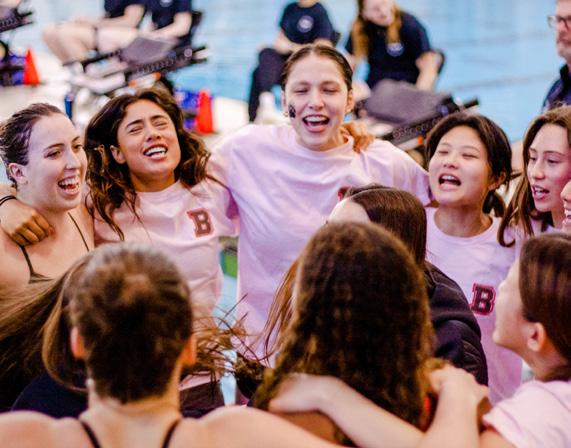

the audience that unity and focused integrity are the keys to healing. “I turn to Maya angelou,” amo said. “I turn to the thought that she put forward when she says that ‘people will forget what you said, people will forget what you did, but people will never forget how you made them feel.’”
The Krieger lecture, named after an undergraduate student with an interest in politics and policy who died shortly after graduating, has brought a number of prominent political figures to campus over the years. “The Krieger lecture, in particular, has been one where we have been able in the past to bring in really prominent people,” Wendy schiller, director of the Taubman Center, said in an interview with The herald. schiller noted that former president barack Obama and house minority leader hakeem Jeffries are among the former guest speakers.

Thursday, February 29, 2024 br OWN da ILyhera L d .COM THE BROWN DAILY HER ALD SINCE 1891 VOLuMe CLIX, Issue 6 WHAT’S INSIDE Women’s Swimming, Diving place fourth SPORTS IGNITE unveils ‘Pepper’s Ghost Exploration’ ARTS & CULTURE Vivi Bubble Tea reopens on Thayer Street METRO SEE SWIMMING PAGE 6 SEE GHOST PAGE 13 SEE VIVI PAGE 5 Sex on the syllabus: intimacy-related courses UNIVERSITY NEWS SEE SEX PAGE 16 see PaNdeMIC PAGE 14 SCIENCE & RESEARCH
see POsT- PAGE 8 postmagazine
SEE REPRESENTATIVE PAGE 3 SEE ADL PAGE 15 SEE RETIREMENT PAGE 3
WEEK IN HIGHER EDUCATION
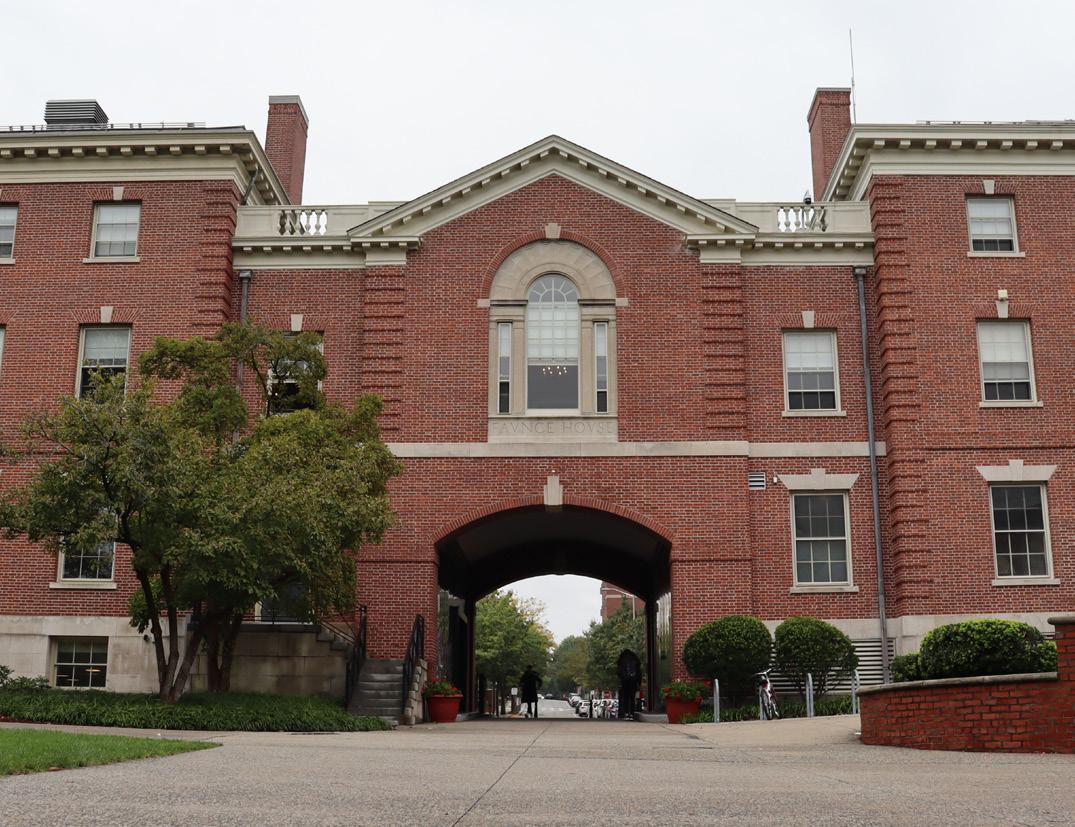
1
Augusta University student killed in homocide at University of Georgia
In an ongoing investigation into the murder of augusta university nursing student Laken riley, Jose antonio Ibarra was charged with seven felony counts.
2
Harvard student hacks Datamatch, publicizes internal data
a harvard student breached data from college matchmaking program datamatch and posted students’ personal information online. In an interview with the Crimson, the hacker explained that his motivations were to make a statement about the risks of putting personal data on the internet.
3
Yale to reinstate standardized test scores amid equity concerns
after four years of maintaining a test-optional policy, the Ivy League university will implement a test-flexible policy, requiring applicants to submit one of four standardized test scores in a stated effort to increase low-income applicants’ acceptance odds.
WEEK IN ILLUSTRATIONS

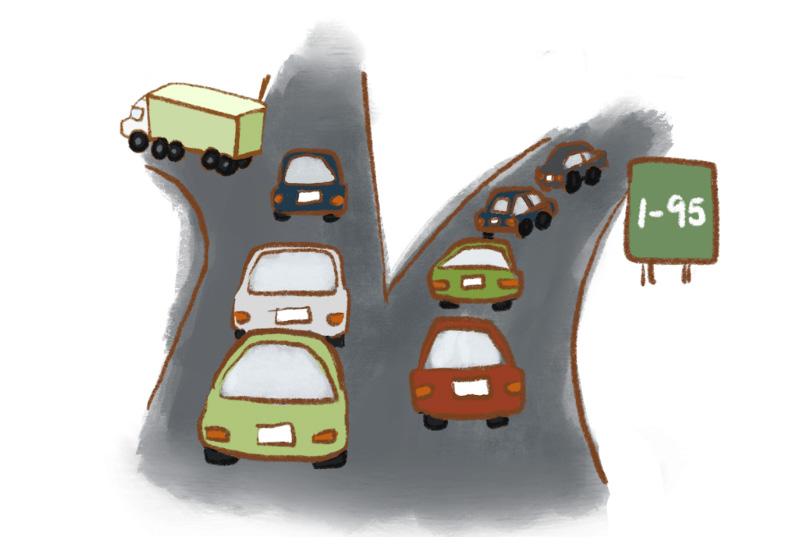


NEXT WEEK
Pa G e 2 Thursday, February 29, 2024 TODAY THIS
Breeze Against Wheeze Chipotle Fundraiser Mar. 3 4:00 p.m. 235 Thayer Street Self Defense Class Mar. 3 12:00 p.m. - 3 p.m. Keeney Quad
Lecture and Workshop w/ Christiane Frey Mar. 4 5:30 p.m. and Mar. 5 10:30 a.m. 190 Hope Street, Rm. 102 Imperial Unsettling: Indigenous and Immigrant Activism toward Collective Liberation Mar. 6 12:00 p.m. 67 George Street, Rm. 104 “DVSS: Early Adversity and Health Risks among Children with Incarcerated Parents” w/ Julie Poehlmann, PhD Mar. 8 12:00 p.m. - 1:00 p.m. 121 South Main Street, Rm. 245 Biomedical Engineering Virtual Information Session Mar. 7 10:00 a.m. Virtual
WEEKEND
rhea rasQuINha / heraLd
TaLIa LeVINe / heraLd
JeNNIFer CheN / heraLd KaITLyN sTaNTON / heraLd
RETIREMENT FROM PAGE 1
In an april 2023 memo to aCurM — which advises the university on business and investment practices — sunrise asked the committee to recommend that the university “require all retirement plan vendors to offer fossil-free retirement plan options.”
“We had heard from a lot of faculty who were concerned that though they were dealing with their finances and their income, they could not choose to personally divest from the fossil fuel industry,” sunrise brown co-founder Isaac slevin ’25 said.
It wasn’t until the committee agreed to meet with student activists that they learned one of their demands had already been partially met. In a Nov. 29 email to sunrise leaders reviewed by The herald — sent a month after the rPC approved the addition of a fossil-free option to faculty retirement plans — Teichert wrote that “aCurM received an update from the brown Investment Office regarding sunrise brown’s recommendation,” and that the addition of a “fossil-free option” had been approved.
The option is only available through Fi-
REPRESENTATIVE FROM PAGE 3
amo discussed what he said was a plan to combat division and build a more unified america, emphasizing that “delivering results is the vehicle for that engagement.”
The congressman specifically listed personal objectives that aimed at targeting the housing crisis, slowing the rapid growth of artificial intelligence and reducing the rise of gun violence. amo emphasized that “continuing to work towards building hopefulness out of despair is the challenge.”
amo was raised in Pawtucket, born into a working class and immigrant family. “The connection to this community is why I ran for this office,” amo said.
The swift resignation of former Congressman david Cicilline in 2023 brought about a special election in rhode Island’s 1st district. after an upset victory in the primary election and a sweeping blowout in the general election this past November, amo’s momentum is carrying him into a tense political space he accredits to the
delity but faculty can invest in funds across both vendors.
The selection process
“While the TIaa social Choice fund is an effective offering that prioritizes certain environmental, social and governance criteria, it is not considered fossil-fuel free,” almeida wrote. “The Committee worked to offer a core fund choice that was not just socially responsible but also fossil-fuel free.”
The rPC’s third-party advisor led the committee’s selection process that considered “the universe of available socially responsible funds available on the Fidelity platform” before ultimately choosing the Vanguard FTse social admiral Index Fund, almeida wrote.
“This fund was selected because of its extremely low-cost exposure to a broad and diversified index,” almeida added. “The Committee also reviewed the fund’s socially responsible screening criteria and was comfortable with the process.”
Fossil fuel exposure
The Vanguard “fossil-free” plan isn’t en-
“dominance of (a) rhetoric of division”. amo touched on both local matters and foreign affairs during his lecture. Topics included the importance of local news, the integration of students who do not speak english as a first language into public schools and the ongoing war between Israel and hamas.
The Congressman, who recently returned from the Munich security Conference, raised concerns about global security, referencing the turmoil taking place in europe. amo recalled meeting “leaders throughout europe whose primary question to me was ‘Is america going to show up?’”
student attendees included both regulars and newcomers to the Taubman Center.
“brown hosts a lot of interesting people on a regular basis, so I try to make my way to as many of those events as I can,” said ariel shifrin ’27, who frequents events at the center.
shifrin heard about the lecture while attending a series of Monday lunches hosted by the Taubman Center. each week, the center invites prominent politicians, policy makers
tirely free of ties to the fossil-fuel industry.
although 0.91% of the fund’s holdings are linked to fossil fuels, it earned Morningstar’s “Low Carbon designation” and the firm’s second-highest possible sustainability rating.
The Vanguard fund’s top holdings include Microsoft, apple, NVIdIa, amazon and Meta. It does not contain investments in companies listed on the Carbon underground 200.
“Vanguard’s ‘FTse-for-good fund’ is probably not high on the list of funds I’d like to see,” Krosinsky said. “I don’t think it’s particularly fossil fuel free, or particularly sustainable.”
but the Vanguard fund will be sufficient for most faculty members who want a sustainable investment option, according to Professor of economics david Weil. “you have to be a pretty damn morally pure person to sort of think ‘I’m upset at brown,’” Weil said. “I think if I was a person who wanted to have a fossil-free investing option, I would say, ‘Okay, now I have one.’”
Faculty guidance
“When people start a job, they think about
UNIVERSITY NEWS
(a retirement plan), and then they don’t think about it a lot afterwards,” Weil said.
The lack of awareness about the new offering among faculty reflects the lack of available education and guidance from universities on retirement plans, Krosinsky said.
“There’s very little guidance provided as to what the options are when it comes to sustainability or anything related, and most faculty don’t even know what to think,” Krosinsky said, noting that the impact of a sustainable offering will largely depend on the awareness of them and guidance about sustainable investment.
“To just kind of bolt on a fund and then five faculty choose into it because they’re the ones who care — it’s not gonna make a big difference and that’s not a perfect fund,” Krosinsky said.
In an email to The herald, almeida said that the university had adhered to legal requirements that govern communications about retirement plan changes.
“Whenever an investment choice is added to one of the retirement plans, brown follows a formal and required communication
process,” almeida wrote in an email to The herald. “brown followed this process and also communicated the changes internally.”
Student activists respond
The retirement plan modification represented a win for student activists at sunrise.
“If you are working at an educational institution, and you have a vested interest in your students future,” sunrise Co-hub Coordinator Caitlyn Carpenter ’26 said, “you should have the option to take your money out of companies that are actively harming your students’ future.”
Weil said that student activists would have the largest impact by making the case for sustainable retirement investments directly to faculty members.
“Faculty at brown tend to be pretty progressive,” Weil said. “If some activist wanted to do more, the thing they should do is hit (up) the faculty and say ‘hey … do your part for the world, switch to the esG fund.’”
“This is a way of putting your money where your mouth is,” he added.
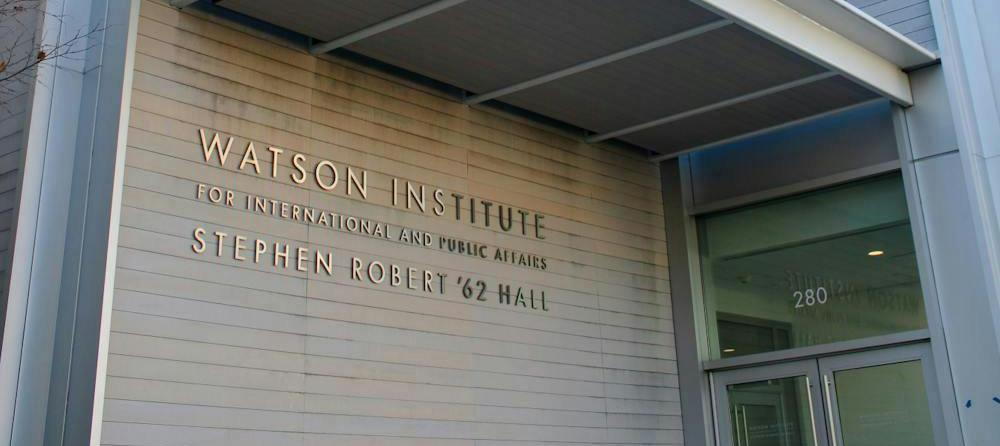
OWeN dahLKaMP / heraLd
and alumni to provide guidance to students. “That’s what we try to do — bring in different types of people,” schiller said.
For some, the young representative is a fresh face. “With lots of polarization (and) lots of partisanship, there’s still things we can
do,” said everton Prospere ’27, who attended the event.
despite being elected a mere three months ago, amo is already up for re-election in November. The congressman emphasized that “the only way that we can keep

General Managers
Benjamin Moshes
Alex Zhou
Sales Director
Samantha Sinensky
Finance Director Mason Mead
Office Manager Cary Warner


moving the ball forward is by holding those in power accountable and making sure that we do this at the ballot box.”
This article originally appeared online at browndailyherald.com on Feb. 26, 2024.
Submissions: The Brown Daily Herald publishes submissions in the form of op-eds and letters to the
Op-eds are typically between 600 and 900 words and advance a clear argument related to a topic of campus discourse. You can submit op-eds to opinions@browndailyherald.com.
Letters to the editor should be around 250 words and respond to an article or column that has appeared in The Herald, or critique or commend The Herald’s editorial decisions. You can submit letters to the editor to letters@browndailyherald.com.
Submissions undergo multiple rounds of editing. These rounds of editing generally take place over the course of one evening, and you may have to respond to edits late in the evening. If you know you will be unable to do so, please mention that in your email, and we will do our best to work with you.
Submissions can build on reporting from The Herald, reporting elsewhere, official statements from the University or other groups and other reputable sources, but they cannot break news or contain information that The Herald cannot verify. Because we cannot publish unsubstantiated information, failure to provide appropriate sources may mean we have to modify or remove unverified claims.
The Herald will not publish anonymous submissions or submissions authored by organizations. Leaders of student organizations can be identified as such but cannot write under the byline of their organization.
The Herald cannot publish all submissions it receives and reserves the right to edit all submissions. All submissions to The Herald cannot have been previously published elsewhere (in print or online — including personal blogs and social media) and must be
Pa G e 3 THE BROWN DAILY HERALD The Brown Daily Herald, Inc. is a financially independent, nonprofit media organization bringing you The Brown Daily Herald and Post- Magazine. The Brown Daily Herald has served the Brown University community daily since 1891. It is published Monday through Friday during the academic year, excluding vacations, once during Commencement and once during Orientation by The Brown Daily Herald, Inc. Single copy free for each member of the community. Subscription prices: $200 one year daily, $100 one semester daily. Copyright 2023 by The Brown Daily Herald, Inc. All rights reserved.
exclusive to The Herald. Once your submission is published in The Herald, The Brown Daily Herald, Inc. owns the copyright to the materials. Commentary: The editorial is the majority opinion of the editorial page board of The Brown Daily Herald. The editorial viewpoint does not necessarily reflect the views of The Brown Daily Herald, Inc. Columns, letters and comics reflect the opinions of their authors only. Corrections: The Brown Daily Herald is committed to providing the Brown University community with the most accurate information possible. Corrections may be submitted up to seven calendar days after publication. Periodicals postage paid at Providence, R.I. Postmaster: Please send corrections to P.O. Box 2538, Providence, RI 02906. Advertising: The Brown Daily Herald, Inc. reserves the right to accept or decline any advertisement at its discretion. 88 Benevolent, Providence, RI (401) 351-3372 www.browndailyherald.com Editorial: herald@browndailyherald.com Advertising: advertising@browndailyherald.com THE BROWN DAILY HERALD SINCE 1891 @the herald facebook.com/browndailyherald @browndailyherald @browndailyherald 134TH EDITORIAL BOARD Editor-in-Chief Neil Mehta Managing Editors Julia Vaz Charlie Clynes Senior Editors Finn Kirkpatrick Kathy Wang POST- MAGAZINE Editor-in-Chief Joseph Maffa NEWS Metro Editors Avani Ghosh Mikayla Kennedy Tom Li Rhea Rasquinha Jack Tajmajer Science & Research Editors Owen Dahlkamp Ryan Doherty Gabriella Vulakh Arts & Culture Editors Isabel Hahn Rya Vallabhaneni Sports Editors Dennis Carey Linus Lawrence University News Editors Samantha Chambers Julianna Chang Owen Dahlkamp Ryan Doherty Katie Jain Anisha Kumar Aniyah Nelson Jennifer Shim COMMENTARY Opinions Chief Alissa Simon Opinions Editors Juliet Fang Anusha Gupta Paulie Malherbe Yael Wellisch MULTIMEDIA Photo Chiefs Claire Diepenbrock Dana Richie Photo Editors Mathieu Greco Lilly Nguyen Kaiolena Tacazon Illustration Chiefs Rhea Rasquinha Jennifer Chen Social Media Chief Kaiolena Tacazon Podcast Editors Finn Kirkpatrick Director of Technology Ty Pham-Swann PRODUCTION Copy Desk Chief Anna Dubey Design Chief Gray Martens Design Editors Tiffany Tran Kaiolena Tacazon Designers Allyson Chen Joyce Gao Michelle Jun Menasha Leport Nathaniel Scott Angela Xu BUSINESS
The Krieger lecture, named after an undergraduate student with an interest in politics and policy who died shortly after graduating, has brought a number of prominent political figures to campus over the years.
New Housing and Human Services Office will coordinate city health, housing services
HHS looks to unify city support for community services after merger
BY TOM LI AND MIKAYLA KENNEDY METRO EDITORS
On Feb. 5, Providence Mayor brett smiley and Chief of Policy and resiliency sheila dormody announced the establishment of the city’s new housing and human services Office.
The new hhs office merges Providence’s healthy Communities Office, housing and Community d evelopment division and senior services. It will focus on affordable housing initiatives, accessibility to behavioral health support and relationships with local community partners, according to a city of Providence press release.
according to emily Freedman, who will serve as the director for the hhs office, unifying the two prior offices allows the city to “align resources to better meet the interconnected needs of our community more effectively.”
“This new office aims to enhance coordination across departments, streamline services and make impactful quality-of-life changes for vulnerable residents by addressing housing, health and senior needs comprehensively,” wrote emily Freedman, who will serve as the hhs office’s direc-

tor, in an email statement shared with The herald.
In addition to Freedman, rachel Ferrera will serve as the director of the hhs’s human s ervices d ivision and William Facente will serve as the director of the hhs’s housing division.
Combining behavioral health and housing services under a single office may create “more opportunity for collaboration and opportunity” when providing these services, according to sandy Valentine, executive director of rhode Island
Communities for a ddiction r ecovery efforts, or rICares
Valentine noted that housing and behavioral health needs are inextricably linked. “It’s really hard to talk to somebody about their recovery from a substance use disorder, when their basic needs in life aren’t being met,” she said.
she has “high hopes” for the new hhs office and anticipates that rICares and hhs “can partner together in the future to create more of those opportunities.”
Facente noted in an email statement
for The herald that the office will “work on the coordination of resources and efforts” to address not only the need for housing, but also the related causes that lead to housing instability — “primarily mental health and substance use disorders.”
Outside of supporting local organizations’ missions, hhs is also tasked with executing existing initiatives that aim to address housing and health in tandem.
The new hhs office and its initiatives fit “into the bigger picture of community
development and resiliency by addressing key social determinants of health and well-being,” dormody wrote in an email statement for The herald.
The office will also collaborate with offices at the state level, such as the executive Office of health and human services, the rhode Island department of health and the state Office of housing and Community development by “coordinating funding efforts and policymaking around health, housing and homelessness,” according to dormody.
Kerri White, director of communications for eOhhs, wrote in an email to The herald that the office, which addresses “two vital basic needs” is “advantageous,” characterizing affordable housing as a factor in overall health.
a s part of its community engagement goals, the new office will serve as a “centralized hub for collaboration and resource allocation,” d ormody wrote.
“The unification of departments will improve accessibility to aid and services by streamlining processes and offering more comprehensive support to residents under one umbrella office.”
“My aspiration is that we complement each other’s efforts,” Valentine said. “We can continue to better work across the state.”
This article originally appeared online at browndailyherald.com on Feb. 26, 2024.
RIPTA proposes changes to service, community members respond at public hearing
BY MIKAYLA KENNEDY METRO EDITOR
rhode Island Public Transit authority’s goal is “100% of the service, 100% of the time,” said ed brown, rIPTa’s director of service planning and scheduling, in the opening of his presentation of the agency’s proposed 2024 service changes at a Feb. 20 Pawtucket public hearing. but for rIPTa riders — as evinced by the public commentary that followed — the service’s proposed changes might mean more challenges than improvements.
In January, rIPTa announced proposed service changes that will affect 33 regular bus routes. The changes include cutting route segments and weekend service, reducing trip frequency and number of trips and entirely eliminating 11 routes across rhode Island. For some routes, the changes hope to increase trip frequency and bring “trip time changes for better service reliability,” according to rIPTa’s press release.
according to rIPTa , the proposed changes are a “direct response to its driver shortage,” reads the press release.
“The labor shortage, which is affecting transit agencies nationwide, has a direct impact on the level of service that rIPTa can provide.”
rIPTa representatives said the proposed service changes would be temporary.
“We plan on reinstating service levels as soon as the workforce permits,” rIPTa Communications director Cristy raposo Perry wrote in an email to The herald.
“a ligning our current staffing lev -
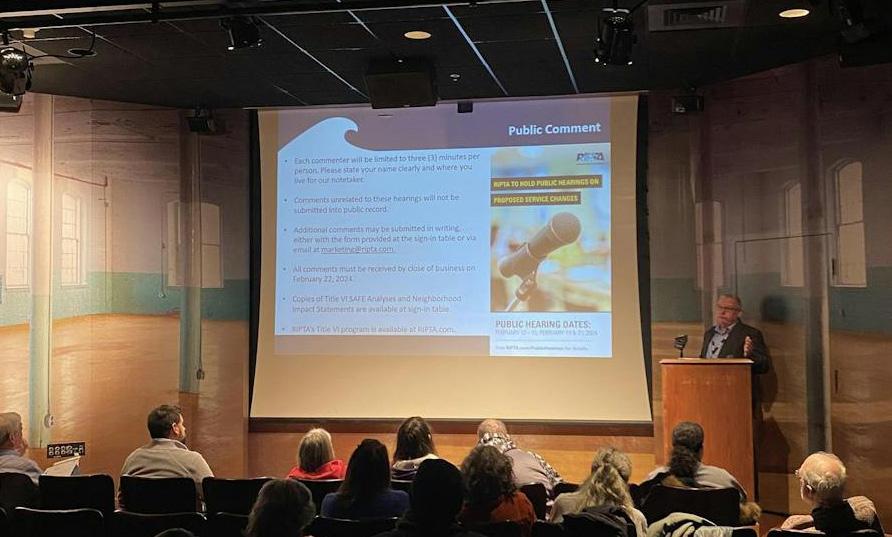
els with the service we can provide will eliminate missed trips and improve the passenger experience,” rIPTa CeO scott avedisian said in the press release.
The public hearing in Pawtucket, which was attended by approximately 55 people, was one of 11 that took place across the state between Feb. 12 and 21. rIPTa plans to “present a summary of the public hearings, including all public comment, to our board of directors at an upcoming board meeting, along with our recommendations,” according to raposo Perry.
d uring public comment, rhode Island political representatives, community members and members of transit advocacy groups shared their perspectives.
The approximately 27 speakers primarily expressed their opposition to the proposed service cuts, sharing how the changes would impact their lives. some in attendance suggested alternatives to rIPTa’s proposed changes.
Common themes included concern for student, elderly and disabled riders, as well as worries about the environmental
consequences of reducing mass transportation. Many speakers also expressed apprehension about their ability to get to work and medical appointments.
several speakers decried the elimination of route 76, which departs from Pawtucket-Central Falls Transit Center and ends at benefit & Thurber. One rider of the 76 noted that people use the route to get to Tolman high school, along with other stops including an elderly complex, an assisted living center and food pantries. raposo Perry noted in an email to The herald that, alternatively, “route 1 serves Tolman high school and the blackstone Valley emergency Food Center.”
One speaker, who identified herself as a student at the Community College of rhode Island, said she was concerned about how the route changes would affect the ability of students to get to CCrI. “I definitely know there are a lot of students that are going to CCrI,” she said. “It would be a great difficulty (for them) to go all the way to Providence and catch one of those buses to go up to CCrI.”
another rider said that route 73, which is facing potential elimination, is “the only bus that I can take to get to work.”
“If I can’t get to work, I won’t have a job. If I don’t have a job, I won’t be able to keep my home and I literally will have nowhere to go,” she said. “There are a handful — at least five — people that I see every morning (who are) disabled who struggle to get on that bus … there is nothing else in walking distance.”
“We know and value that rIPTa is a vital service for our riders. however, without additional drivers, we are left with no option but to reduce service or eliminate low performing routes,” raposo Perry wrote about the elimination of the 73 bus route.
raposo additionally shared that “In 2022, rIPTa severely decreased service frequency on high performing routes in response to an unprecedented labor shortage,” but has now been “forced to eliminate routes that do not perform well instead of cutting service that carries a high ridership.”
Tom Cute, who has been a rIPTa bus driver for 44 years and now works with the Providence streets Coalition, said he feels that rIPTa is what “the environment needs.”
“Transit jobs are green jobs,” he said.
Cute also voiced support for decreasing fares as a solution to increase ridership. “right now, I believe rIPTa should cut the fares to a dollar,” he said, adding that “ridership went through the roof” when rIPTa introduced the r-line free fare pilot. according to rIPTa data, year-over-year ridership increased by 40% while the pilot program was in effect.“If you make it available and good,” Cute said, “people will use it.”
raposo Perry wrote that the service changes are a consequence of a shortage
of bus drivers and “are not due to low ridership.”
Cute also expressed support for increased wages for rIPTa drivers, which he believes would help with recruitment and retention. “I think the increase in wages will actually help get folks in the door because the starting wages are too low,” he said.
raposo Perry shared that “the board voted to approve a collective bargaining agreement with the amalgamated Transit union division 618 that would increase the starting driver wage from $21.71 per hour to $25.33 per hour.”
she added “with the new increased driver starting wage, we are hoping to recruit more drivers so that we can reinstate service in the future.”
speaking to her hopes for the future of rIPTa , amy Glidden, the co-chair of r .I. Transit riders — an advocacy group for public transportation in the state — highlighted the Transit Master Plan, adopted by the state Planning Council in december 2020. “We have a great plan that our government has really done very little to implement. I think rIPTa has tried where they can with very little funding.”
raposo Perry explained that “rIPTa’s service goals, which are outlined in the Transit Master Plan (TMP) and adopted by the state, are to increase access to transit through more frequency, more days of service on most routes (7 days per week), a longer span of service, service to new areas and potentially new modes of service.”
“at this time, we do not have funding to implement service improvements as called for in the Transit Master Plan,” raposo Perry added.
This article originally appeared online at browndailyherald.com on Feb. 26, 2024.
Pa G e 4 Thursday, February 29, 2024 METRO
HOUSING
NaThaN GOLd / heraLd
The new office will focus on affordable housing initiatives, accessibility to behavioral health support and relationships with local community partners.
TRANSPORTATION
Community members express concerns over route changes, accessibility, fares
MIKayL a KeNNedy / heraLd
In January, RIPTA announced proposed service changes that will affect 33 regular bus routes. According to RIPTA, the proposed changes come in direct response to its driver shortage.
WEB EXCLUSIVE

RIDOT establishes new freeway connection

Japanese grocery to open in downtown Providence
READ IT ONLINE
BROWNDAILYHERALD.COM

BUSINESSES
Vivi Bubble Tea on Thayer Street reopens following renovations
Store’s interior debuts modern makeover while retaining pink, cozy charm
BY MIRA WHITE SENIOR STAFF WRITER
a fter a temporary closure for renovations, Vivi b ubble Tea returned to Thayer s treet on Friday with a new look.
Vivi first opened its doors on Thayer s treet in 2017, attracting customers with its pink aesthetic and decorations featuring the franchise’s sugar-skull mascot. The shop’s cozy ambiance provided customers with an energy different from other bubble tea shops on College h ill.
The shop reopened this past Friday after closing for about one month. While its interior has been given a modern makeover, Vivi retains its pink and cozy charm that first drew customers to it.
“It’s been seven years, so the old stuff is getting outdated,” Vivi Owner and Manager Jason Chou said, explaining the reason for renovations. “We wanted something that can compare to other bubble tea places.
The shop’s interior has been transformed with comfortable pink and white booths. The furniture change has been accompanied by new decor — ornamental plants, new posters and redone overhead lighting — inviting

New pink
customers to enjoy the space.
“I think the remodel is really cute,” wrote Jenny Zhang ’25.5 in a message to The h erald. “I like the new pink sofas as they’re more comfortable than the old wooden tables and chairs.” a s Vivi reopens, its essence remains
unchanged as “a comfortable place where people can sit down and hang out,” Chou said. The shop’s menu is also set to stay the same.
“Personally I think Vivi drink and food are underrated mainly because of its underground location, but the
change of the store makes it more attractive and spacious,” Zhang wrote. “I approve of Vivi.”
This article originally appeared online at browndailyherald.com on Feb. 27, 2024.

360 High School community pushes to stop school closure at RIDE meeting
dropout and low graduation rate and low math and e nglish proficiency, The herald previously reported. Currently, PP sd plans to merge 360 into the Juanita s anchez e ducational Complex’s new Life s ciences Institute.
non-verbal, was not initially allowed to enter the room. his mother followed the appropriate process to sign up to make a comment at the meeting, but the open forum period had ended about one minute before her arrival.
notice requirement, meaning that to speak at the Feb. 27 meeting, individuals were required to send an email by 5:30 p.m. on Feb. 26.
BY CIARA MEYER SENIOR STAFF WRITER
dozens of community members, advocating against the closure of Providence’s 360 high school, arrived at a Tuesday meeting of the r.I. department of education’s council for elementary and secondary education. The Council did not directly acknowledge their demands.
The closure was announced to 360 staff and teachers on Feb. 6. since then, advocates have rallied for more transparency around closure processes, increased community engagement in district decision-making and to keep 360’s doors open.
Leaders in the Providence Public school d istrict attributed the closure to financial constraints, a lack of a dvanced Placement opportunities, a high
due to capacity constraints, only around 25 community members were admitted into the main meeting room for the Tuesday event. Others waited in the hall or in an overflow room.
In the meeting room, advocates pointed to 360’s performance and low cost as arguments for its preservation.
The meeting’s agenda did not include the 360 high school, and the Council did not respond to comments made during the open forum period. “The agenda is informed by a variety of factors, including the broader needs of the statewide educational community,” wrote rIde spokesperson ashley Cullinane in an email to The herald.
Madalena ribeiro, a special education teacher at 360, described how one of her students, who is
referring to the incident, those in the hallway began chanting “Let them speak” about 50 minutes into the meeting. The chants progressed into “do your job,” “Fire the Commissioner” and “Protect our schools.” after several minutes of chanting, the police were called and the meeting went on recess.
state representative enrique sanchez attended the meeting and addressed the Council during recess. “The reason why this keeps happening is because community members are upset … people deserve an opportunity to speak,” sanchez said.
“We have a process (for speaking) that is transparent (and) posted in multiple places,” responded Chief of staff at rIde Krystafer redden. “We are not having a conversation.”
The public comment process has a 24-hour advance
The american Civil Liberties union of rhode Island sent a letter on Feb. 28 requesting that the Council reconsider this policy. “such a requirement is burdensome, unnecessary (and) detrimental to public participation,” wrote aCLu r .I. executive director steven brown.
“We strongly urge board members to consider scheduling meetings in an alternative location, whether within the rIde building or elsewhere, when they have strong reason to suspect there is likely to be a large presence from the public,” brown wrote in his letter.
When the meeting resumed, over five security guards and police officers were present.
Police were also called at the Feb. 15 PPsd school b oard meeting, where community members advocated for 360 high s chool, The herald previously reported.
Pa G e 5 THE BROWN DAILY HERALD METRO
TOM LI / heraLd
booths, vivid posters and redone overhead lighting invite customers to enjoy Vivi’s space, drinks and eats.
BEYOND BROWN
RIDE’s Council of Elementary and Secondary Education does not acknowledge demands
Women’s Swimming and Diving place fourth hosting Ivy Championships
Bruno shatters twelve program records over weekend
BY GALEN GIBB CONTRIBUTING WRITER
This past week, brown (4-3) hosted the annual Ivy League Women’s swimming and diving Championships, placing fourth with 1036 points. Women’s swim and dive narrowly lost to yale, which tallied 1069 points for third place, while harvard (1317.5 points) and Princeton (1403 points) commanded second- and first-place finishes, respectively.
despite missing out on the top three overall, bruno displayed their prowess in short- and middle-distance swimming, with multiple podium placements in individual and relay events. during the meet’s inaugural races on Wednesday, Jenna reznicek ’25, Gillian Tu ’27, Lillian Klinginsmith ’26 and sam scott ’24 took third in the 200 medley with a time of 1:37.84, shattering the program’s record of 1:38.73, which was set in 2017.
“We knew each person in the relay would have to execute a ‘best possible scenario’ split,” reznicek wrote in an email to The herald. “so watching each girl hit that ‘best possible scenario’ split, one after another, was such a proud and exhilarating feeling. as our final freestyle legs swam in, it was so exciting watching the scoreboard and watching the time stop under the previous school record time.”
Later in the day, two other program records fell in one race. Zehra bilgin ’25, Morgan Lukinac ’26, anna Podurgiel ’25 and Kelly d olce ’26 swam a combined 7:08.77 in the 800 freestyle relay to finish second to Princeton, beating the record set in 2023 by more than three seconds.
HOCKEY
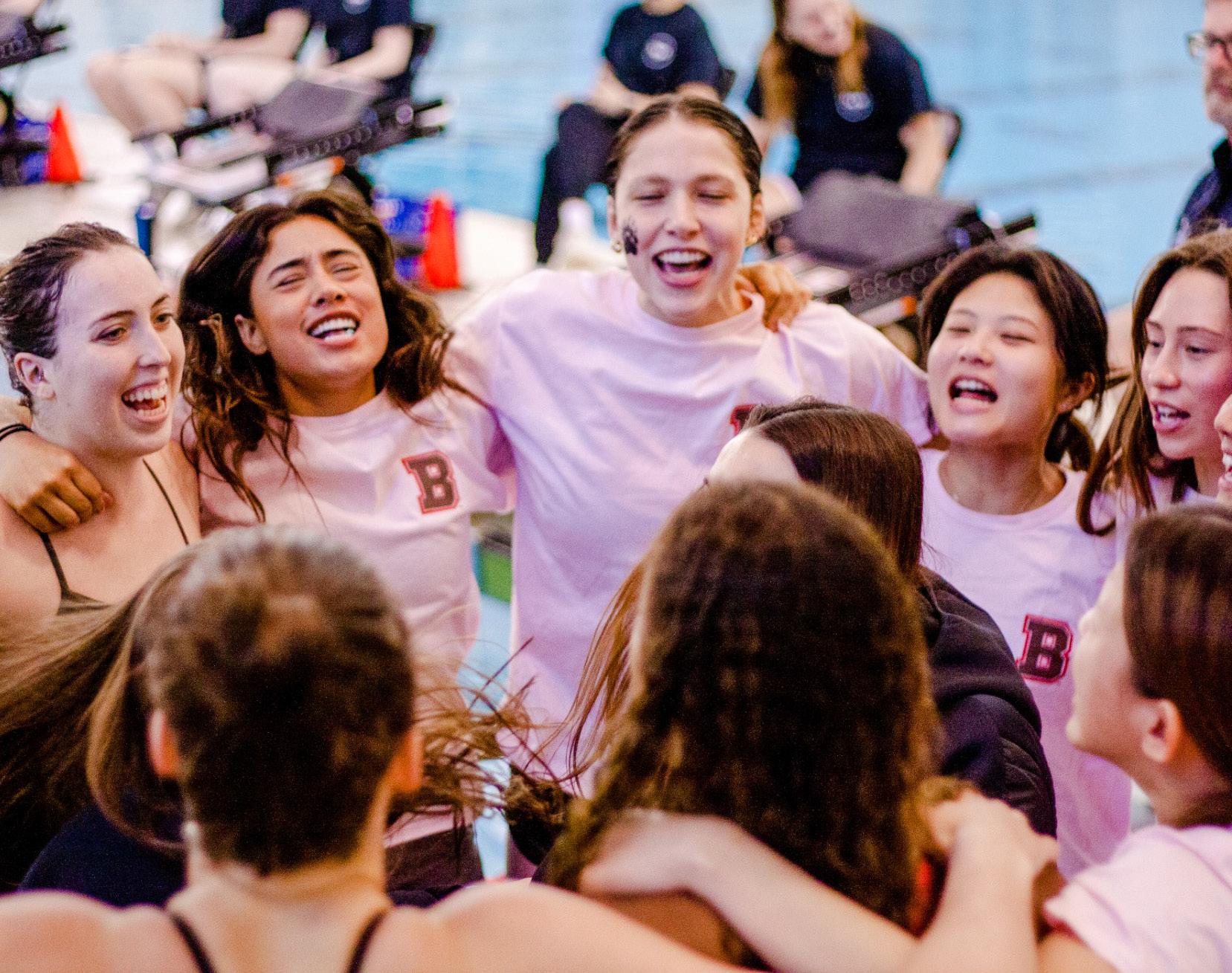
Lukinac herself set a bruno record in the 200 freestyle as part of the relay.
“My favorite race of the meet was definitely the 800 freestyle relay,” Lukinac wrote in an email to The h erald.
“My main training partners, Kelly d olce, a nna Podurgiel and Zehra d uru b ilgin push me the most every single day, and I am so grateful to have them all together in one relay.”
“The 800 free relay was the first event of the meet for us, so we were fresh and the energy on deck was electric,” Lukinac added. “It was so fun to be neckand-neck with Princeton’s relay, (and) it was a great race.”
The eight b runo swimmers who represented the first two relay races performed exceptionally well for the remainder of the meet. Of the twelve program records broken in this year’s championships, they contributed to nine of them, either as individual competitors
or relay members.
In Thursday’s 200 freestyle relay, s cott, Lukinac, d olce and b ilgin logged a 1:30.22 (a b runo best) to take third, trailing behind h arvard and Princeton squads that set new pool and Ivy record times. In the 50 freestyle, scott and Lukinac clinched third and fourth place, respectively.
In the one-meter diving final, Isabella George ’27 scored 274.40 to place fifth. In the three-meter diving contest, elena yeh ’26 placed eighth with a final score of 216.90.
Friday’s results arguably featured the most surprising win for b rown in the entire championship. In the 100 butterfly finals, Klinginsmith, who had placed sixth with a time of 53.56 seconds in the preliminaries, not only shaved off a full second — completing the race in 52.53 seconds — but also edged out harvard’s sydney Lu by 0.02 seconds to

SCORES RECAP
win first place. The day concluded with Lukinac winning gold in the 200 freestyle and reznicek, yu, Klinginsmith and Lukinac collecting bronze in the 400 medley relay. reznicek also placed second in the 100 backstroke. The race “has become a very competitive event in the Ivy League in the past couple of years,” r eznicek wrote in an email to The herald. “so from the beginning of the season, knowing the high level of talent of the girls I would be swimming against at the end of the season motivated me to push myself in practice.”
On the final day, the bears registered three more program records. Lukinac finished second in the 100 freestyle at 48.53 seconds, then joined Klinginsmith, d olce and b ilgin to take second in the 400 freestyle relay. bilgin would conclude the championships for brown by finishing third in the 200 butterfly.
Women’s hockey grinds out home playoff win over Rensselaer Polytechnic 1-0
BY DENNIS CAREY SPORTS EDITOR
On saturday night, the women’s hockey team (12-15-3, 7-12-3 eCaC) won their first postseason match 1-0 against rensselaer Polytechnic Institute (13-18-4, 5-16-1 eCaC) in an overtime nail-biter. The game was the first home postseason match for bruno since they were the eCaC tournament runner-ups in the 2006-07 season.
“(home ice) is huge for us because the administration does a great job of creating a space for us,” said head Coach Melanie ruzzi. “When you come to a game … (there is) a lot of good energy.”
Following up last weekend’s heart-breaking defeats against Colgate (27-6-1, 18-4-0 eCaC) and Cornell (22-6-1, 17-5-0 eCaC), the bears were out for revenge against the ninth-seeded engineers. This season, the rPI-brown matchup had been played twice before this weekend with the bears winning one 3-2 and losing the second 2-0. Needless to say, tensions were high this weekend.
That was the story of the first period: tension. bruno, who came into saturday’s game having conceded very few power plays throughout the season, gave away two very early advantages to the engineers.
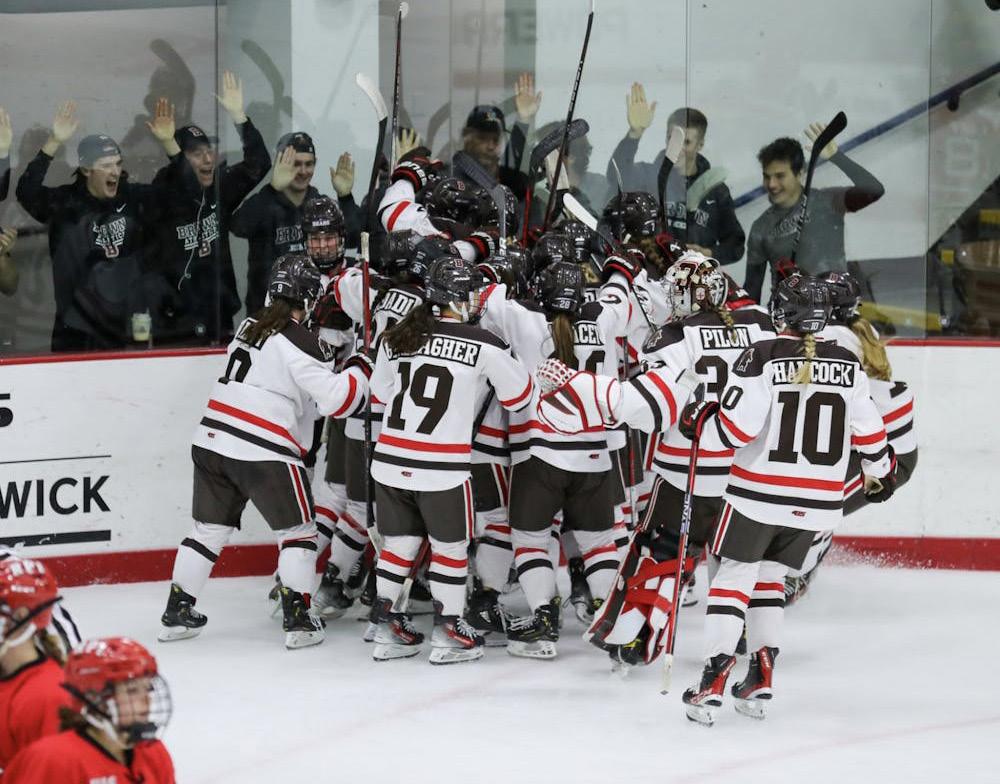
“both teams had some playoff jitters, to be honest,” ruzzi said. “We’re two even teams, and we’ve split with them this year. I think it was a bit of jitters more than anything else.”
Neither team seemed to be able to find their feet early in the game. The play was disorganized among both teams, with the puck constantly flying up and down the ice with no clear possession leaders. The engineers capitalized on this, taking 10 shots to bruno’s seven, and forcing a “wonder save” out of goalie Kaley doyle ’24.
after the bears had mitigated intense
pressure from the engineers, rensselaer fired a shot over doyle that seemed impossible to reach. but in the defining moment of the match, doyle kicked her leg out, sending the puck over the net to save the bears’ game and their season.
“It definitely wasn’t perfect, but I knew she was going high, so I kind of kicked my leg up hoping to get a piece of it. Obviously, it worked out,” doyle said. “I mean, it wasn’t too pretty, but I guess whatever works.” after an engineer-led first period, the bears came out in the second looking like a brand-new team. The game was still a
defensively-sided affair, but bruno managed to win possession and go on long shooting spells to test rPI’s keeper.
“Obviously, I think both teams might have been a little shaky, both just kind of skating hard, not really getting anywhere,” forward Jess Ciarrocchi ’25 said. “but we’re like, alright, we got one (period) under us. (We) settled in, found our pace and then took it to them.”
The bears fired seven shots in the second period, which, while still slow, eclipsed the engineers’ measly two shots. From this point onward, the bears’ offense outshot the engineers in every subsequent period.
The third period was a dominant affair for the bears, firing 14 shots compared to rPI’s six. The engineers found themselves in late danger after conceding two power plays in the third, where brown managed to find longer offensive spells. unfortunately, none of the 14 shots were decisive, but the bruno crowd could feel that the goal was coming.
and their feelings were correct — the fans would only have to wait one period longer in sudden death for bruno’s winning goal. after the engineers came out dangerously, firing the first two shots of the period, the bears battled back and took two shots themselves.
after ellie Gauvin ’26 fired the puck into a scrum in front of the goal, it bounced around aimlessly for a seemingly endless amount of time until it happened: The puck
came flying out of the bedlam off the stick of Ciarrocchi, slamming itself in the back of the net. The bears’ home support exploded.
“because the rebounds were there, because we had good screens and good traffic in front of goal, whoever was going to score that winning goal in this game, it was going to be something dirty,” ruzzi said. “so that’s exactly the goal I think we would have guessed.”
The celebrations were put on hold while the officials checked the goal for a possible high stick penalty. but after the goal was given, the crowd exploded once again. the bears had finally done it.
“My heart dropped because I couldn’t believe it went in,” Ciarrocchi said. “I hit it from behind so I couldn’t tell what angle it was going in at, and I saw it bounce in and just lost it. The first thing I (thought was), ‘I gotta go see my teammates, we just scored this goal.’”
“I think everyone just had the same feeling of relief,” Ciarrocchi added. “We were working hard the whole game, especially the last half, like we wanted it bad. and it was sudden death.” saturday’s goal was only Ciarrocchi’s second of the season.
Next weekend, the bears head away to Colgate to play a three-game series from March 1-3 for the eCaC quarterfinal round.
This article originally appeared online at browndailyherald.com on Feb. 25, 2024.
Pa G e 6 Thursday, February 29, 2024 SPORTS
WOMEN’S Vs sIeNa SOFTBALL Vs. Le MOyNe W 11-3 Vs harVard L 7-10 Vs uT MarTIN L 2-12 (7 INN.) WATER POLO Vs uT MarTIN L 2-3 Vs uT MarTIN W 13-6 MEN’S BASEBALL Vs. PrINCeTON L 1-5 Vs saCred hearT W 40-6 BASKETBALL Vs harVard L 17-23
COurTesy OF ChIP deLOreNZO VIa brOWN aThLeTICs
Jess Ciarrocchi ’25 scores sudden death winner in overtime
L 3-4 W 7-3 Vs buTLer W 14-12 Vs. WaGNer L 3-7 Vs. MIddLe TeNNessee W 10-0 Vs beLLarMINe L 8-9 Vs uC daVIs L 193.900-194.625 Vs. COrNeLL GYMNASTICS L 193.900-195.400 Vs yaLe L 193.900-195.800 Vs uPeNN Vs. COLuMbIa W 66-64 Vs. COrNeLL W 78-74 Vs.QuINNIPIaC L 2-5 ICE HOCKEY WRESTLING SWIMMING & DIVING
Jess Ciarrochi slots an unlikely winning goal for her second on the season.
COurTesy OF KaIOLeNa TaCa
VIa brOWN
s
ZON
aThLeTIC
The Bears scored three program records on the final day of the meet.
TRACK & FIELD
Odenigbo ’24, Bernard ’25 claim Ivy League titles for indoor track and field at Heps
Women finish fourth, men finish fifth in Ivy League Championships
BY LYDELL DYER SENIOR STAFF WRITER
at the Ivy League heptagonal Indoor Track and Field Championships hosted by harvard this weekend, brown women’s track and field placed fourth with 84 cumulative points and the men’s team placed fifth with 45 points.
at the competition, athletes Chiamaka Odenigbo ’24 and rudecia bernard ’25 won Ivy titles for the women’s pentathlon and women’s high jump, respectively.
“The competition went well,” wrote head Coach Ken hunt in an email to The herald. “We as a staff are so proud of how our student-athletes competed this weekend. I believe it is an indication of our upward trajectory.”
In the s aturday pentathlon game, Odenigbo defended her Ivy League title and won gold for the second year in a row. her 4,027-point finish not only beat her previous record of 4,012 points but also became the second-highest score in brown program history.
“It was time to defend my title,” Odenigbo wrote in an email to The herald.
“The energy at (the heptagonal) is always amazing,” she reflected after the contest. “It is loud, it is electric and it breeds an extra level of adrenaline and, in turn, great performances.”
With a time of 8.54 seconds, Odenigbo blazed into first place in the 60-meter-hurdles. a 1.75-meter leap in the high jump secured her another top podium position. but following a second-place finish in the shot put and third in the long jump, with distances of 12.12 and 5.48 meters respectively, Odenigbo was pitted in a tight battle for first place overall.
“I didn’t have a strong lead over second place,” she wrote. “I was nervous going into the last event — my weakest one.”
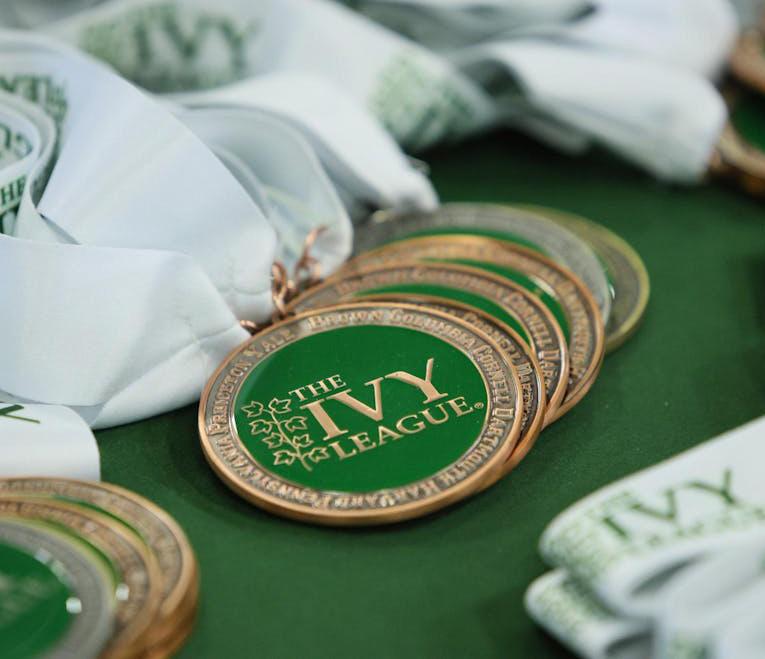
Despite individual performances, contests like the Ivy League Championships reward team performance — and as a whole, the Bears shone.
but after completing the 800-meter race with a time of 2:26.33, she was able to clinch the pentathlon victory.
“being able to secure the win after running a personal best by five whole seconds gave me a feeling I’m really struggling to put into words,” Odenigbo wrote. “That definitely made this win a lot sweeter.”
It was also a record-setting day for bernard, who competed in the high jump. In a gold-winning performance, she leaped 1.76 meters and onto the top podium position.
“This title was truly special to me,” bernard wrote in an email to The herald.
It wasn’t just bernard and Odenigbo who shattered the record books. John Mc-
Neil ’24 delivered a 7.66-meter performance in the men’s long jump, not only setting a new personal best but establishing a new school record. his second-place finish was only a quarter of an inch shy of Princeton’s Greg Foster.
The heptagonal “brings the team spirit out of a sport that often focuses on individuals,” bernard wrote in an email to The herald. “On both the men’s and women’s teams, it was great to see people rooting for each other so hard that we were getting kicked out of certain areas of the venue.”
Lauren yeboah-Kodie ’24 earned three podium positions across her three events. “I wanted to stay calm in dealing with the
chaos of overlapping events,” she wrote in an email to The herald. “I (take it) one event or jump at a time. I don’t want to give into fear or feelings of dread, and I also don’t want to feel complacent; I want to stay competitive and aggressive.”
On saturday, yeboah-Kodie competed in the long jump. Leaping into third place with a 6.17-meter jump, she set a new personal best while securing the second-farthest long jump in program history. Jada Joseph ’25 finished right behind her, landing in fourth place with a 5.99-meter jump.
“We have a really nice dynamic,” yeboah-Kodie wrote about Joseph. “It helps to have someone where we can push and
motivate each other … Jada especially has inspired me to become a more competitive and confident jumper, and athlete overall.” “We definitely feed off each other’s energies. When one person does well, it’s invigorating,” she added.
yeboah-Kodie doubled down on sunday, finishing second in the 60-meter hurdles. she crossed the finish line in 8.58 seconds. Close behind was Odenigbo, who finished in third with a time of 8.62 seconds. The day before, during the preliminary round, she had run the third-fastest time in school history, 8.52 seconds.
The duo also competed in the triple jump, with yeboah-Kodie taking home third place with a jump of 12.91 meters — a new personal best — and Odenigbo finishing fifth with a personal best of her own of 12.34 meters. between them, in fourth place, was Joseph, who leaped 12.68 meters.
“Training and competing with these ladies (is) a lot of fun,” Odenigbo wrote about Joseph and yeboah-Kodie. “We’re never short of smiles, funny dances or supportive hugs and cheers. but we’re also very competitive with each other during practice.”
My teammates “push me in every aspect all of the time, and I am so grateful to get to share the multi-experience with them,” Odenigbo added.
despite individual performances, contests like the Ivy League Championships reward team performance — and as a whole, the bears shone.
In the men’s 60-meter hurdles, Marcus Gillespie ’24 set a new personal best with his second-place, 7.93-second finish. Jason estrada ’26 placed third in the 400-meter race, traversing the lap in 48.03 seconds — the fourth fastest time in brown history.
In the women’s shot put, Kendra ezeama ’24 claimed the third spot with a throw of 14.74 meters.
The bears now look ahead to the eCaC Championships held in boston from March 1 to 3.
This article originally appeared online at browndailyherald.com on Feb. 27, 2024.
Brown to host 2025 Ivy Madness basketball tournaments at Pizzitola Sports Center
Bears basketball receives first opportunity to bring playoffs to Pizz
BY LINUS LAWRENCE SPORTS EDITOR
The Pizzitola sports Center will host the 2025 Ivy League men’s and women’s basketball tournaments — more commonly known as Ivy Madness — according to a Feb. 26 university press release.
Ivy Madness was first held in Philadelphia in 2017 and has since been hosted in rotation on different Ivy League courts. The 2024 tournaments will be held from March 15 to 17 at Columbia’s home court in New york City.
For brown’s basketball teams — both of which are currently tied for a playoff berth with three games remaining in the 2023-24 season — the announcement signifies the potential to play the most pivotal games of the year in front of a packed home crowd in Providence.
“The idea of playing on our home court is an awesome thing to think about for next year, and it would be amazing to be able to play in such high-stakes games on our own floor with
friends and fellow students able to watch in person,” wrote Grace arnolie ’26, a women’s basketball guard, in an email to The herald.
“having the chance to play on our home court for Ivy Madness next year is definitely special,” wrote Kalu anya ’26 of the men’s team. “The Pizz is special to us, and having our amazing fans supporting us throughout the game (would) definitely help us overall.”
both teams’ coaches echoed the excitement generated by the opportunity to host playoff games in the Pizzitola.
“I’m excited for our institution and our city to host an event of such quality and significance,” said head Coach Mike Martin ’04 in the press release. “Our state is so passionate about college basketball, and hosting Ivy Madness in our amazing city of Providence is something for everyone to look forward to.”
“We are thrilled to bring the electrifying atmosphere of Ivy Madness here next March,” Coach Monique Leblanc said in the press release. “College basketball championships are the gateway to March Madness and we are thrilled to be hosting this premier event.”
This article originally appeared online at browndailyherald.com on Feb. 27, 2024.
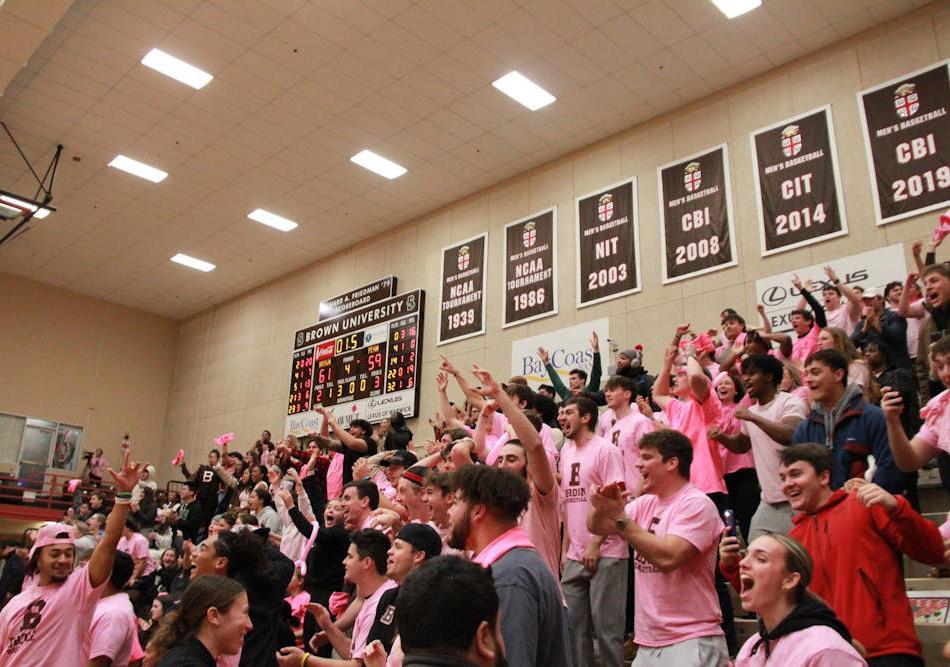
Pa G e 7 THE BROWN DAILY HERALD
SPORTS
COurTesy OF brOWN aThLeTICs
BASKETBALL
COurTesy OF brOWN aThLeTICs
For Brown’s basketball teams, the announcement signifies the potential to play the most pivotal games of the year in front of a packed home crowd in Providence.

post-
Letter from the Editor
Happy Leap Year Day! To all those born on February 29, your patience in aging is admirable. Happy birthday! Even if you aren’t a leap year baby, I hope you will all take advantage of this additional day. Maybe you’ll use it to rest. Maybe you’ll use it to lock in at the Rock. Whatever you decide is worthy of your gracious extra day, hopefully it is something enjoyable. Unfortunately, my GCal is full from 10 a.m.10 p.m., but at least I don’t have an exam. I wonder what leaps we may take this year: over a puddle, frog, a tattoo or piercing, hair dye. The possibilities are endless. This week I took a leap and got a tattoo of two cats cuddling in the shape of a heart. It was definitely worth the pain. I also learned that most of the post- editors want to take a leap and shave their heads. If you suddenly see a group of really cool-looking people walking around with shaved heads, stop and say hello!

ISSUU.COM/POSTMAGAZINEBDH
ISSUE 4

This week in post-, our writers are taking leaps through nostalgia, remembering family, childhoods, and friends. In Feature, the writer reflects on a recent family vacation with extended family where she had to navigate generational political differences. In Narrative, our managing editors reflect on a day they would love to re-live with their extra day this year, and our writer shares her opinions on the seasons through a series of vignettes and talks about how she evolves with them. In A&C, one writer discusses feeling connection to spiritual ity through music, and the other reflects on his personal relationship with language and how he observed it changing with new phases of relationships and age. In Lifestyle, one writer discusses the history of tweed fabric and provides an overview of its significance. The other writer, a mid-year transfer student, gives advice on how to make new friends. Last, but certainly not least, we have a Nikki-themed mini-crossword. Nicki who you may ask. Try it and find out!
I look forward to the remainder of this leap year and what leaps I may take. I hope to make small leaps each day. Leaps are what help push us out of our comfort zone and push us into a place of growth. Be bold, take a leap, and commit to reading post- every week. I can assure that it will help you grow.
See Full Issue:
FEB 29 VOL
33
Gabrielle Yuan The Delightful Ever Changing of Seasons Samira Lakhiani Family Ties managing eds Leap Year Meditations Olivia Cohen Take Me to Church Zoe Park How to Meet New People Ben Herdeg The "I" in Goodbye Sean Toomey Tweed and Me
Elijah
A&C
Editor Taking a leap of faith,
Puente
Managing

“I
wish we had tails so we could wag them.”
“I’ve
decided to microdose happiness with a little bit of Dr. Pepper.”

days in February 1 2 3 4 5
Groundhog Day 2/29 Snow Day Valentine's Day Lunar New Year
Rihanna’s Birthday Spunky Old Broads Day February Fools
My dog’s birthday (2/26) Bachelor Mondays

1
7
3 4 5 8

Starships
by Will Hassett
Across Pedi's partner 1
5
6 Preps onions, perhaps Outdo
Nikki' presidential candidate Slightly open
7 8 Down Nicki; Queen of Rap 1
2
4 5 2
“But the sameness can also be relieving. As I listen to white noise, even if I’m lying awake, I remember that my sleeplessness has persisted within me since my infant days, and—in a way— that is comforting.”
— S ophie Pollack-Milgate, “White Noise”


“I want to melt down every moment, keep them in a heart-shaped locket around my neck. But time is like water between my fingers. The scene always ends, and a new one arrives, burning just as brightly.”
— Emily Tom, “Here and There” 2.25.22
EDITOR-IN-CHIEF
Section
Section Editors
Section Editors Emily Tom
Ananya Mukerji
LIFESTYLE
Managing Editor Tabitha Lynn
Section Editors
Jack Cobey
Daniella Coyle
HEAD ILLUSTRATORS
Stella Tsogtjargal Junyue Ma
COPY CHIEF
Eleanor Peters
Copy Editors
Indigo Mudhbary
AJ Wu Gabi Yuan
Corwin
Liza Kolbasov
Gabi Yuan
Elena Jiang
Sofie Zeruto
Sarah Kim
Samiha Kazi
Aalia Jagwani
AJ Wu
Olivia Cohen
Ellie Jurmann
Sean Toomey
Sarah Frank
Emily Tom
Evan Gardner
Audrey Wijono
Jeanine Kim
Sydney Pearson Samira Lakhiani
Cat Gao
Indigo Mudhbary Will Hassett
Ayoola Fadahunsi
Joyce Gao
Eleanor Dushin
Malena Colon
Alaire Kanes
Want to be involved?
Email: joseph_maffa@brown.edu!
Pa G e 9 THE BROWN DAILY HERALD February 29, 2024 7 Want to be involved? Email: joseph_maffa@brown.edu! post –
Joe
Maffa FEATURE
Klara
son-Schmich
Managing Editor
David -
Elaina
Editors Addie Marin
Bayard
CULTURE
ARTS &
Managing Editor Elijah Puente
Christine Tsu Emilie Guan
Managing
Katheryne Gonzalez
MEDIA
EDITORS Kelsey
Tabitha
Gray
Amber
Alexa
Romilly
NARRATIVE
Editor
SOCIAL
HEAD
Cooper
Grandolfo LAYOUT CHIEF
Martens Layout Designers
Zhao
Gay
Thomson STAFF WRITERS Dorrit
3
Amtrak's high-speed option Germany's goalkeeper What one does with their little eye Qatar's capital 6
6 7 8 9 10
OPINIONS
jonath ’24, Rosenzweig ’24: Why we walked out of Jonathan Greenblatt’s talk
On Feb. 22, brown’s Office of Institutional equity and diversity hosted Jonathan Greenblatt, the director of the anti-defamation League, to give a talk titled “an evening with Jonathan Greenblatt.” We are the Jewish students who initiated a walkout during Greenblatt’s talk, along with dozens of our brown divest Coalition allies.
Our walkout on Thursday was an act of protest against both the adL and OIed for platforming and spreading Greenblatt’s dangerous rhetoric. We continue to be disappointed that our university — which claims to uphold a commitment to free intellectual exchange — would think it is productive to platform a speaker and an organization that so blatantly works to shut down dialogue.
If Greenblatt had been hosted by brown students for Israel or some other student organization on campus, we would have simply chosen not to attend the event. but Greenblatt was invited by the OIed — the institutional body tasked with keeping our campus free of hateful discrimination. such an action by OIed leadership was wholly inappropriate. OIed said their intention in hosting the event was to spotlight a “conversation about antisemitism” in the united states. but Greenblatt’s harmful rhetoric about Palestinian, arab, black and anti-Zionist Jewish students prevented the OIed from fostering a legitimate dialogue. as a public event hosted by the brown administration in the name of free speech, it required a public protest in response.
Greenblatt argued that “we don’t need safe spaces on campuses like brown,” but instead should create “brave spaces” in which to engage in honest dialogue. but Greenblatt’s talk was not one such brave space conducive to dialogue between peers with differing opinions. by beginning his address with, to quote former adL employees, an “intellectually dishonest and damaging” conflation of anti-Zionism and antisemitism, Greenblatt demonstrated that he was unwilling to engage with anti-Zionist Jews like ourselves in good faith. We could
not continue to participate, given that his totalizing conflation of anti-Zionism with antisemitism made constructive dialogue immediately impossible. during his speech, Greenblatt made several references to history. however, by not acknowledging the fact that there has been vocal Jewish opposition to political Zionism since its inception, he blatantly ignored a rich swath of Jewish history to maintain his totalizing campaign against anti-Zionism. Greenblatt espoused an exceptionally broad, generous, and, as he put it, “simple” definition of Zionism as “the right of Jews to self-determination in their ancestral homeland,” citing meaningful Jewish texts for examples of “the yearning for eretz yisrael.”
“
on the lives of millions. It cannot be separated from the Nakba, the displacement and ethnic cleansing of 750,000 Palestinians in 1948, the sustained violence for the last 75-plus years or the current genocide in Gaza. Greenblatt spoke boldly about “Jewish self-determination” but conveniently left out the rights of Palestinians to self-determine in lands on which they have also been living for millennia. harkening back to the unequivocally harmful falsehood that Israel was born on a “land without people for a people without land,” his reductive and false definition of Zionism erases an entire population and their history, enabling the indiscriminate killing of Palestinians we see unfold each day.
We did not walk out because we are unwilling to engage in dialogue. We walked out because we felt our continued presence would endorse the harmful narrative Greenblatt
“
In the spirit of specificity, the “Zionism” that resulted in the current state of Israel refers to a modern political movement, not just an ideology or longer-held spirituality. Modern political Zionism is not just about nebulously defined “self-determination.” regardless of one’s individual interpretation of Zionism, it has manifested historically as the idea that self-determination must take the form of a nation-state that privileges the Jewish people over Palestinians.
Political Zionism has negative material impacts
To be anti-Zionist is to reject the idea that Jewish self-determination is mutually exclusive with Palestinian self-determination — or that an apartheid state is appropriate for any people’s liberation. When Greenblatt defines anti-Zionism as the idea that “Jews do not deserve freedom and self-determination in their homeland” and declares that “anti-Zionism is antisemitism,” he devalues and delegitimizes genuine experiences of antisemitism as a means of furthering his political ideologies.
Through his false equivalencies, Greenblatt minimizes the very real threat of antisemitism — instead making racist and hateful claims in the name of fighting that threat.
Greenblatt then went on to make the harmful claim that self-identifying as an anti-Zionist is “like saying in 1964, ‘I’m not a racist, but I just don’t think we need to pass the Civil rights act or end Jim Crow.’” First, we must address the glaring fact that the state of Israel has been credibly charged with apartheid against Palestinians, making this a wholly unfit comparison. second, we must recognize the incredible difference between the end of Jim Crow and the establishment of a Jewish nation-state in Mandatory Palestine. Failure to pass the Civil rights act would have meant continued segregation in the united states. Opposing Zionism and the ethnic cleansing of Palestinians is simply not comparable.
We have a responsibility to our community. We did not walk out because we are unwilling to engage in dialogue. We walked out because we felt our continued presence would lend credence to the harmful narratives Greenblatt treats as irrefutable fact.
Our university, a place meant to foster intellectual curiosity, platformed a man whose employees quit over the fact that his campaign conflates anti-Zionist organizing and white right-wing extremism. If even former employees at the adL believe that Greenblatt’s campaign endorses hate, how can we be expected to behave otherwise?
despite the OIed’s stated intentions, dialogue with Greenblatt was never going to be possible. Platforming his false narrative precludes the potential for productive discourse. his heinous rhetoric dehumanizes students, particularly Palestinians, and invalidates our identity as anti-Zionist Jews.
monique jonath ’24 and Ariela Rosenzweig ’24 can be reached at moniqueariela123@gmail.com. Please send responses to this op-ed to letters@ browndailyherald.com and other op-eds to opinions@browndailyherald.com.
Rahman ’26: Brown must adopt institutional neutrality
In a hearing before the house Committee on education and the Workforce, then-Presidents Liz Magill of Penn and Claudine Gay of harvard, as well as President sally Kornbluth of the Massachusetts Institute of Technology, were asked if “calling for the genocide of Jews” violates each president’s respective universities’ rules on bullying and harassment. In a shocking move to many, all three presidents repeatedly evaded the question. Gay explained that whether such statements constitute harassment in violation of policy was “depend[s] on the context.” The resulting backlash sparked the eventual resignation of Magill and Gay.
When reading about this saga, what strikes me most is that these presidents were entirely correct in stating that speech is actionable if, and only if, “the speech turns into conduct,” as Magill stated. Indeed, b rown’s own Code of s tudent Conduct states “whether the alleged conduct constitutes harassment depends on the totality of the particular circumstances.” Likewise, the d epartment of e ducation’s Office of Civil r ights writes that harassment “must include something beyond the mere expression of views, words, symbols or thoughts that some person finds offensive.” a nd yet, to many, their overly legalistic and tone-deaf responses came off as incendiary given the universities’ inclination to endorse certain social movements without concern for neutrality.
higher education is under attack, and in large part we have allowed ourselves to become vulnerable to the onslaught because we have inconsistently applied our principles of free inquiry. so when administrators, such as Magill or Gay, cite academic freedom as the reason to tolerate harmful speech, they have little credibility. brown must avoid the same fate — but the absence of formal institutional
neutrality stands in the way.
The idea that we should allow hateful speech might seem contradictory to the progressive society
social norms. Therefore, when asked why their commitment to principles is suddenly important today, when it comes to antisemitism, they have no
“ “
Higher education is under attack, and in large part we have allowed ourselves to become vulnerable to the onslaught because we have inconsistently applied our principles of free inquiry.
in which we live. but the fact is that at the margins it is difficult to define hate speech. For example, when protesters chant “from the river to the sea” or “globalize the intifada,” some, myself included, see that as antisemitic, at the very least. Or when conservatives respond to protests against police brutality with the slogan “blue Lives Matter,” many, myself included, see that as racist, at the very least. but given the multitude of interpretations of phrases like these, it is impossible to reach a universally-accepted definition of hate speech.
While the three presidents at the congressional hearing were correct that university responses to any speech should be context dependent, the contemporary actions of their institutions have not reflected this belief. In recent years, universities have become shameless in taking institutional stances and censoring speech which contradict
response. When asked why their institutions didn’t take a stronger stance after October 7th, when they forcefully and immediately responded to the russian invasion of ukraine and the murder of George Floyd, they have no response. The tendency of universities to take a stance contradicts their recent responses to antisemitism on campus, which includes hedged, legalistic language.
I have previously written that universities must not take stances on political matters, but in an increasingly illiberal america, I now believe we ought to go further. It’s time for higher education to adopt institutional neutrality. While in theory it sounds simple, in practice, it’s much harder. after all, where do you draw the line? On what matters can you comment?
brown, as a principle, must refrain from condemning its own scholars or making statements
on national and international current events when they don’t directly pertain to campus. Instead, our focus should be on supporting students and promoting scholarship surrounding controversial issues. That’s not to say that universities should never speak out. In cases where there are on-campus incidents of bias or harm or threats to the very institution of higher education, it is absolutely appropriate for universities to convey its condemnation. but looking inward, universities can again fulfill their roles as centers of scholarship and discourse.
as succinctly put by harvard Professor of history alison Frank Johnson, “critics count the number of hours between a tragic event and a statement and use that as a metric to decide how much and whether the administration cares.” by responding to every crisis, today’s universities have dug their own grave. The McCarthy-esque show trial of the hearing was a natural conclusion.
In response to the recent turmoil on campus, harvard is currently exploring a policy of institutional neutrality. Why should we wait for brown to learn the same lesson the hard way?
Institutional neutrality can also help to alleviate the tremendous pressure universities face from donors — who wield undue and improper influence — from Washington, from the public and from students who have come to expect their institutions take positions on every issue. but most of all, it will allow higher education to regain the trust of the american people in the principles and missions we hold dear.
‘Tas Rahman ’26 can be reached at tasawwar_rahman@brown.edu. Please send responses to this opinion to letters@browndailyherald.com and other op-eds to opinions@browndailyherald.com.
Pa G e 10 Thursday, February 29, 2024
Sandhu '25: Shiny object syndrome plagues our generation
In a fast-paced world, our generation’s obsession with the new is pervasive. From the latest smartphone to fleeting fashion trends, we have grown up in a society caught in an incessant cycle of novelty. This fixation with the new has become deeply ingrained in our culture, shaping our consumer behaviors, societal norms and even our sense of identity.
The shiny object syndrome describes how the prospect of a new purchase distracts us from our current possessions, leading to an endless addiction to consumption. but, this impossible hunt for novelty only provides dissatisfaction. In our relentless pursuit of the new and rejection of the familiar, we risk losing sight of the value of longevity. While innovation and progress are undoubtedly important, they should not come at the expense of stability, sustainability and continuity.
at the heart of this phenomenon lies rapid product cycles, in which goods and ideas are rapidly introduced, consumed and discarded in favor of the next big thing. The consumer market epitomizes this pursuit of novelty, with tech giants releasing new iterations of smartphones, laptops and gadgets at an alarming rate. each upgrade promises enhanced features and capabilities, causing consumers to fear that they are missing out while rendering yesterday’s models obsolete, all in the blink of an eye.
similarly, the fashion industry, for example, operates under a model of planned obsolescence, churning out new collections at breakneck speed to capitalize on trends. Fast fashion has revolutionized the way we dress, offering affordable clothing that mimics the styles showcased on catwalks and social media feeds. but, this dis-
WEB EXCLUSIVE
Hudes ’27: Literary arts courses are small because they have to be
posable approach to fashion comes at a steep cost, both environmentally and ethically, by bolstering overconsumption and waste. again, marketers take advantage of our short-term attention, allowing us to neglect the warnings of long-term climate threats.
Our obsession with the new extends beyond material possessions. Cancel culture also thrives on the constant search for the latest scandal or controversy, as social media users eagerly jump from one outrage to the next. One
While innovation and progress are undoubtedly important, they should not come at the expense of stability, sustainability and continuity.
day, a public figure is adored and cheered on by millions of fans. The next day, a tabloid blasts a negative rumor and they boo louder than they ever cheered. Cancel culture illuminates how obsession is only appealing to the consumer’s mindset when it is new and shiny. although more accountability for public figures can be beneficial, community sentiment must critically discern when and how it can wield its influence for good.
O’Riordan ’27: Brown needs to do more to close the information gap for applicants
In the realm of politics, short product cycles are evident in the rise of charismatic candidates who capture the public’s imagination with bold promises and unconventional tactics designed to win votes. elections have become battlegrounds of spectacle and sensation, where substance is often overshadowed by style, and long-term vision is sacrificed for immediate gratification. donald Trump’s political career demonstrates how an outsider can disrupt Capitol hill norms by appealing to extremism, targeted but memorable language, and a campaign built on rhetoric over substance.
The rise of short-form media platforms like TikTok has further accelerated our obsession with the new, offering a constant stream of bite-sized content designed to capture our attention. Flashy captions and click-bait have so much influence on american public opinion. Consequently, the consumer becomes flippant because tomor-
row’s content may change their viewpoint entirely with little consequence. When media circulates on the basis of short-term entertainment and instant gratification instead of relevance and accuracy, misinformation spreads for the sake of profit.
For college students, the shiny object syndrome can look like doom-scrolling as a stress coping mechanism, seeking out extreme experiences by partying and using substances, or letting tangents distract from a research objective in a paper. With our busy lives at brown, it can be hard to resist the temptation for something new and exciting to combat daily monotony. but, we must try to remind ourselves not to fall into this trap, because our lives’ meanings should be grounded in valuable, sustained experiences. The real world is made up of our friends, family, a beautiful campus and wonderful professors, all waiting to be cherished. happiness may not be about the next dopamine hit, but maybe about the comfort of friendship, well worn habits, or that reliable cup of coffee. Without the familiar, we may spend our lives lost in an endless chase for something better, when we are surrounded by people and things that are already worth coming back to.
Meher Sandhu ’25 can be reached at meher sandhu@brown.edu. Please send responses to this opinion to letters@browndailyherald.com and other opeds to opinions@browndailyherald.com.
This article originally appeared online at browndailyherald.com on Feb. 26, 2024.
Aizenberg ’26: In Defense of Ryan Lochte

Editorial: Brown should prioritize its foundational learning goals when addressing AI
This semester, there is a new phrase haunting professors’ syllabi: artificial intelligence. each course seems to have a different statement on aI: For some classes, the use of aI is defined as plagiarism; for others, it is permitted as long as students cite how the technology was used. some syllabi don’t mention aI at all; some enthusiastically encourage students to utilize it. brown professors should have discretionary power over aI regulation, but the university should also offer guiding principles for the non-negotiable elements of learning that must be preserved as part of a brown education.
Over the summer, the university released a statement regarding the impact of aI on brown’s academic mission. The communication encouraged faculty to outline clear rules about what is and is not permitted in their classrooms. Other universities have released similar statements, including guides on how to write aI policies for syllabi. Given brown’s wide range of disciplines and their unique learning goals, it makes sense to let professors implement their own course-specific policies instead of a blanket university regulation. but if we want to safeguard the fundamental features at the heart of student learning, brown must recognize both the threat and potential of these technologies.
There is significant value in learning without aI. Chatbots like ChatGPT deprive students of a learning process that is central to academic growth and skill building. by using ChatGPT, students don’t have to struggle through the challenging, iterative process of writing a research paper, solving a problem set or completing a coding project. These tools allow students to bypass the process of using and developing their critical thinking skills. rather than prioritizing
learning, aI systems maximize productivity and efficiency, which explains why industries have embraced them with open arms — but also why academia should proceed with caution.
This doesn’t mean that brown should ban aI com-
think critically about the uses of aI.
Two of brown’s liberal learning goals most threatened by aI models like ChatGPT are 1) Improving speech and writing, and 2) enhancing aesthetic sensibility. aI reduces writing and art, time-intensive cre-
We call on Brown to strike a balance between the drawbacks and benefits of AI within its academic philosophy in order to protect students’ potential to learn, grow and contribute to the world around them.
pletely. Instead, the university should consider how it can integrate aI as a complementary feature of its academic mission. In doing so, it can both continue to promote its liberal learning goals, while also equipping students with the skills to enter an increasingly digital job market. For example, just like there is a WrIT requirement, perhaps brown could create a “technology” requirement. Courses under this requirement might include classes on computer science, aI prompt engineering, technology literature, cybersecurity and more. This way students can engage with aI in a way that complements rather than conflicts with a liberal learning education, and develop a better ability to
ative practices, into near-instant processes of creation. The integrity of literary and visual arts courses, as well as any courses that require some mode of generative writing or creativity, is threatened by readily available aI tools online. If brown truly believes in the importance of these two learning goals, then the university should ensure that they cannot be compromised by easy access to aI creative generation. This could be accomplished, for example, by having more in-class creative assignments that eliminate the possibility of reliance on aI tools.
similarly, with their ability to write quick solutions for almost any homework problem, aI chatbots offer
an easy way for students to bypass the work that goes into quantitative or coding-based courses. brown professors should respond to this threat with the same philosophy held toward using the internet to search for answers since ChatGPT’s answers also come only from information already existing online. While online tools can solve the problems presented to us as practice, uncovering and addressing new problems requires a human brain capable of critical reasoning — something aI is not yet capable of emulating.
These are just a few examples of the ways that aI can compromise the integrity of brown’s learning goals. as the capabilities of artificial intelligence grows, so too will the possibilities for action that the university should consider to protect its academic mission. We call on brown to strike a balance between the drawbacks and benefits of aI within its academic philosophy in order to protect students’ potential to learn, grow and contribute to the world around them.
Editorials are written by The Herald’s editorial page board and aim to contribute informed opinions to campus debates while remaining mindful of the group’s past stances. The editorial page board and its views are separate from The Herald’s newsroom and the 134th Editorial Board, which leads the paper. This editorial was written by the editorial page board’s members Paul Hudes '27, Paulie Malherbe '26, Laura Romig '25, Alissa Simon '25 and Yael Wellisch '26.
This article originally appeared online at browndailyherald.com on Feb. 25, 2024.
Pa G e 11 THE BROWN DAILY HERALD OPINIONS
“ “
BROWNDAILYHERALD.COM READ IT ONLINE
“ “
‘American Fiction’ calls out Black stereotypes in fiction
Satirical film tackles race in publishing industry, largely succeeds
BY JOHN SEXTON CONTRIBUTING WRITER
Cord Jefferson’s deft directorial debut feature “a merican Fiction” criticizes the media’s celebration of inaccurate racial stereotypes that pander to white audiences. Initially released in 2023, the movie juxtaposes the absurdity of such stereotypes with the reality of b lack a merican lives in all their complexities.
The movie follows a sharp and stubborn writer named Thelonious “Monk” e llison (Jeffrey Wright), a wily wordsmith with a small readership. e llison, who is b lack, receives euphemistic complaints from publishers about his latest manuscript, but he knows what they’re really saying: it’s not a “ b lack book.”
Later at a literary seminar, Monk’s panel receives a low turnout. e veryone attends another writer’s panel, s intara Golden’s (Issa rae). s he gives a dramatic reading of a passage from her latest sensationalist success, “We’s Lives in d a Ghetto,” a book that panders to b lack stereotypes. Monk stands and watches from the back of the room. In a rare moment of cinematic splendor, as s intara finishes her reading, a white woman spiritedly rises to her feet and applauds directly in front of Monk, rendering him invisible.
REVIEW

“American Fiction” makes an exceptionally convincing argument that Black artists need to be able to tell new stories.
One night, as a joke, Monk begins to pen a novel titled “My Pafology” under the pseudonym s tagg r . Leigh. It’s a s intara-esque story with a panoply of cliches and stereotypes that usually represent b lack characters in a merica. In the words of Monk, it has “deadbeat dads, rappers, crack.” h e sends the derisive draft to his agent a rthur (John Ortiz) and encourages him to jokingly send the story to publishers. “Look at what they expect us to write,” Monk says. The joke misfires, however, and Monk finds out he’s struck a $750,000 publishing deal.
The film is at its most cunning when it acts as a crusade against the fondness of academia, publishers and the public for art that reduces b lack people to ridiculous stereotypes. White people, the film argues, engage with this art largely in order to feel absolved. For instance, Monk’s — or really, Leigh’s — publishers are excited to publish the novel around Juneteenth because they know white people will be “conscious stricken.”
a s Monk begins to adopt the increasingly stereotypical persona of s tagg r Leigh, he only further succeeds to captivate a merican audiences. d uring these
‘Avatar: The Last Airbender’ live-action remake, while
Remake abandons original’s feel-good humor, characters’ complexity
BY KATIE JAIN UNIVERSITY NEWS EDITOR
r emaking a classic is never easy — especially when the original is a cartoon unrestrained by budget, special effects or the laws of physics in which characters can manipulate water, earth, fire and air. b ut the Netflix live-action remake of the beloved series “avatar: The Last a irbender,” released Thursday, juggles those difficulties with grace — injecting life into the animation’s vibrant cities, mystical forests and terrific powers. b ut while the 2024 version successfully captured the most fantastical, majestic details of the show, it failed to highlight what made the show truly unique: humorous heart and the loveable characters.
The world of a TL a , which was first released as an animated series in 2005, is organized through four element-based nations — water, earth, fire and air. While some people have the power to control their nation’s respective elements, only the avatar can master all four. a ang, a young but powerful airbender, discovers he is the next avatar right before the Fire Nation starts its domination of the other nations. While trying to run from his fate, a ang becomes trapped in a ball of ice for 100 years, incidentally avoiding the Fire Nation’s annihilation of the a ir Nation. When a ang is awoken by
two young Water Tribe siblings, Katara and s okka, he is still 12, but the rest of the world has moved on, suffering under the Fire Nation’s rule. The show then follows the trio’s efforts to free the world.
The live-action remake features eight episodes, each around an hour, compared to the original’s 20 episodes of about 23 minutes each. a s a result, the remake combines stories and plotlines that were separate in the animated version, introducing certain key characters, like a zula and Fire Lord Ozai, long before they’re introduced in the original — shifting the focus of the series from the lighthearted individual adventures the characters experience along their journey to the greater overarching threat.
The animated show consistently reaffirms that even though the future of the world depends on a ang’s success, the focus remains on four children in the present moment and their smaller, less impactful day-to-day lives. The original series begins with Katara and s okka in a boat engaging in pretty standard sibling squabble. Their lives are, of course, affected by the Fire Nation’s domination and their personal loss, but that’s not the only thing they’re thinking about — they are also just kids.
The live-action show, on the other hand, begins with the Fire Nation’s violence, a ang (Gordon Cormier) learning he’s the avatar and the destruction of the s outhern a ir Temple — all of which are shown throughout the animation in more strategically placed flashbacks. In the new show, when Katara (Kiawentiio)
moments, many of which are hilarious, the screenplay is razor-sharp. Moreover, the film makes an exceptionally convincing argument that b lack artists need to be able to tell new stories. Instead of reducing b lack lives to stereotypes, Jefferson insists that the scope of narratives b lack artists get to tell should be enlarged. Much of the film, however, is not a tautly-wound satire. When Monk isn’t writing his highfalutin novels or masquerading as s tagg r . Leigh, he spends time with his family and faces authentic a merican anxieties. h is mother is di -
agnosed with a lzheimer’s. h is brother gets divorced when his ex-wife catches him with a man. Monk himself begins to date his lawyer neighbor. The rhetorical effect of these scenes is clear: they show the real lives of b lack a mericans, unlike the sensationalist stories that the market demands. These are the stories that should be told.
Though Monk’s mundane moments with his family have a noble purpose in the film, it can be argued that they grow tedious. Whereas half of the movie is a scintillating, satirical and quick-witted social commentary, the other half consists of more quiet moments: dinner conversations, seaside strolls and a frankly forgettable marriage plot. The juxtaposition is jarring, and though it’s clearly intentional, it is understandable if viewers find themselves wishing Monk was in another humorous and provocative exchange with his publishers instead of chit-chatting with his family’s housekeeper.
It’s unclear whether “a merican Fiction” is compelling throughout the entirety of its two hour run time, but it soars more often than not — especially during its more satirical and scathing moments. In the end though, Jefferson makes quite the argument that new a merican fictions are needed. h e’s bored of the same books that line the shelves — he wants a new story.
This article originally appeared online at browndailyherald.com on Feb. 27, 2024.
faithful to original, lacks humorous heart
and s okka (Ian Ousley) do fight, it’s because of much more serious issues. a nd while a ang is still a playful kid like in the original — with Cormier especially leaning into a ang’s adorable 12-year-old charm — most of his lines are deep, burdened monologues. h e doesn’t have the same childish puppy love for Katara, and he isn’t as distracted by his constant desire to have fun and play games.
This, in turn, costs the remake some other key opportunities for depicting well-rounded and developing characters. In the animation, a ang’s desire to go penguin sledding as soon as he wakes up from a 100-year coma helps show how he reintroduces Katara and s okka, who had to grow up too fast, to childhood. s okka’s dry, self-focused one-liners, though present in the remake, are cut down significantly, giving his character less room to grow into a serious and generous person by the end. Katara, in contrast, isn’t as strongwilled, making her determination at key moments feel more out of place and making her appear to be almost too perfect of a character.
u ncle Iroh (Paul s un- h yung Lee) and Zuko ( d allas Liu) face a similar issue. e ach character bears remnants of their original traits, but not enough to create the personalities audiences know and love. Lee’s Iroh is still jolly, wise and tea-obsessed, but a lot less so. h e’s serious when he’s supposed to be, which in some ways makes him more human and in others limits his appeal as the loveable old man you constantly underestimate. a s a result, the remake misses out on several opportunities

COurTesy OF NeTFLIX
ATLA’s themes of hope, sacrifice, liberation and domination stand true now as much as ever, and the live-action remake still embodies these ideas while bringing the magic, cities and characters of the original to life.
to juxtapose Iroh’s good humor with Zuko’s dramatics, though Liu perfectly personifies the sullen, raging prince.
b oth are still complicated and sympathetic characters — they just aren’t quite as entertaining.
a TL a’s themes of hope, sacrifice, liberation and domination stand true now as much as ever, and the live-ac -
tion remake still embodies these ideas while bringing the magic, cities and characters of the original to life. b ut the show’s efforts to send a message end up swapping heartfelt humor for pointless monologues.
This article originally appeared online at browndailyherald.com on Feb. 26, 2024.
Pa G e 12 Thursday, February 29, 2024 ARTS & CULTURE
REVIEW
COurTesy OF MGM sT udIOs
EXHIBITION
Brown Arts Institute and Centre for the Less Good Idea collaborate on ‘Pepper’s Ghost Exploration’
Project is second ongoing collaborative residency of IGNITE Series
BY CAVAN AGATONE STAFF WRITER
Last week, The Centre for the Less Good Idea — a performance group based in Johannesburg — collaborated with the brown arts Institute to hold a series of performance-based workshops using “Pepper’s Ghost,” a theatrical technique that uses specialized mirrors to create hologram-like images and narratives.
The performance — part of a collaborative spring 2024 arts residency under baI’s IGNITe series — was shown four times, each instance called a “sharing.” In each sharing, the “Pepper’s Ghost” mirror technique was also projected onto the floor in order to allow performers to contribute to the illusion both behind and in front of the mirror.
Performers presented five acts in each sharing, which varied from session to session due to differing schedules of performers. The sharing on Feb. 23 at 8 p.m. began with an “energizer” in which the performers sang and danced in a circle while greeting each other and inviting the audience to join in.
Performer, choreographer and theatre-maker Nhlanhla Mahlangu explained the reasoning behind the “sharing” label.
“(The audience) is coming to watch the artist’s thinking, and that’s the biggest privilege,” he said. “In a performance, you see a finished product, which to me, is only a residue of the process.”
Mahlangu has been involved with The Centre for the Less Good Idea since its formation in 2016. he worked initially as a collaborator for the Centre’s first season and then as a curator beginning with the second season.
“each artist had an idea, and these ideas don’t have to be in any advanced stage,” Mahlangu said, explaining the process for “Pepper’s Ghost exploration.” “What I realized is that as artists, we kept making the same work — just different fragments of the same work.”
his work on “Pepper’s Ghost exploration” was an “extension of a piece (he) did in Johannesburg.”
according to an interview in TLmagazine with William Kentridge, the centre’s founder, the name for The Centre for the Less Good Idea comes from a Tswana proverb: “when the good doctor can’t cure you, find the less good doctor.”
Likewise, Mahlangu said, “a studio is the safe place for stupidity — no matter how wrong your idea is, you are allowed to present it. There are great minds that are able to develop it with you.”
One of the acts of “Pepper’s Ghost exploration,” entitled “Thrown/Throne,” featured performer and conceptualiser Neil
McCarthy thrashing around on the floor while an image of a quickly-rotating chair was projected onto the mirror, creating the illusion of a person struggling to remain on the chair. another act, “Git black,” conceptualized by JaMario stills, featured footage from the short documentary “Fieldwork” and text from the book “Mules and Men,” both by Zora Neale hurston.
The performers explained the inspiration behind their acts during a Q&a session after the performance. One performer also taught the audience the lyrics and melody to a song featured in the last act.
architecture and slavic studies concentrator Jasmin Lin ’24 became involved with “Pepper’s Ghost exploration” after speaking with Kentridge. “It was interesting to see how it all came along,” Lin said. “We started building off the momentum.”
Many performers cited personal experiences and other artworks as inspiration for their work on the project.
“I asked (performers) to think about their earliest memories of themselves, and we started working from that memory,” Mahlangu said. “We are constantly projecting our history: our excitements, our traumas, our fears.”
The baI’s collaborative residency with The Centre for the Less Good Idea is a part of the IGNITe series, which launched in October 2023 to “showcase a diverse array of offerings” from the “brown arts ecosystem,” according to the baI website.
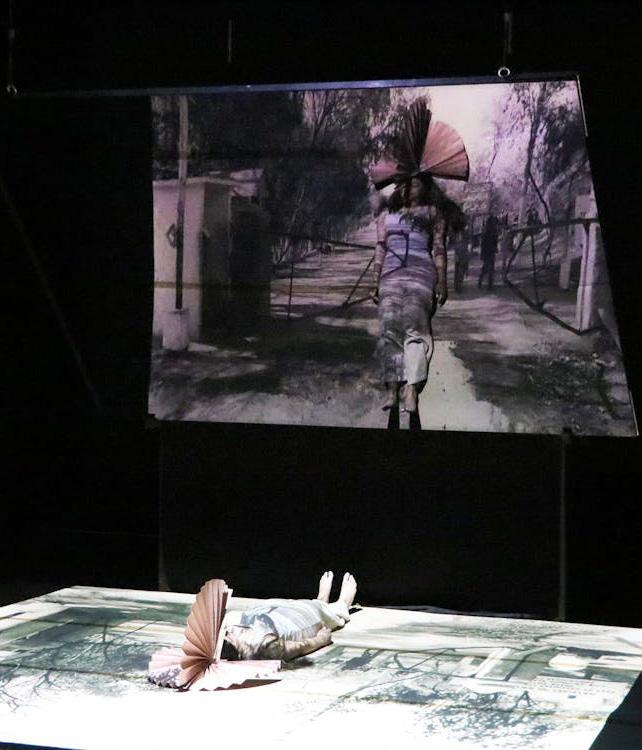
COurTesy OF brOWN arTs INsTIT uTe
The mirror technique was also projected onto the floor in order to allow performers to contribute to the illusion both behind and in front of the mirror.
The third part of the residency, “studio Process and Political Change: The Case of William Kentridge,” is a lecture by rhode Island school of design professor Leora
The Off-Meal-Plan Plan: Market Shares in the bag
For February, finding inspiration from BMS, Korean classics
BY JENNIFER CHEN ILLUSTRATIONS CO-CHIEF
hello dear herald readers,
I have something funny to tell you: Nobody at the train station would ever guess that I was carrying a whole butternut squash, carrots and several turnips in my suitcase. I obtained that unlikely cargo from my first brown Market shares haul, which I brought home during the long weekend to share with my family. Thanks to bMs, I spent my February experimenting with Korean recipes and keeping my friends well-fed and happy. here are a few meals I tried:
Vegetarian Kimbap

before the semester started, I thought about which recipes might help me survive the semester — ideally quick ones that I could mass-produce for busy days. Kimbap was first on my mind (major credit to Maangchi on youTube for this recipe). I invested in a sushi mat, but Maangchi said she can roll kimbap without one, so I believe you can too.
you will need:
UPCOMING PERFORMANCES
“Meridith Monk & Vocal Ensemble”
Meredith Monk, joined by her ensemble, performs “Cellular songs” which reflects on cells and human society.
saturday, March 2 at 7 p.m.
Lindemann Performing Arts Center
Providence Medical Orchestra Concert
Musicians from Warren alpert Medical school and other biomedical professionals perform music by anontin dvorak and Gabriela Lena Frank.
saturday, March 2 at 7:30 p.m.
Central Congregational Church
The “Anything Goes” Concert a student composed and performed concert by Fermata Composer’s Collective.
saturday, March 2 at 3 p.m.
Grant Recital Hall
Brown University Orches-
tra: March Concert
The brown university Orchestra, conducted by Mark seto, perform music by Jessie Montgomery, richard danielpour and aaron Copland.
Wednesday, March 6 at 7:30 p.m.
Lindemann Performing Arts Center
Leafy greens. Taiwan spinach is the traditional go-to, but organic pea shoots (from bMs!) work well
Carrots
Tofu or your protein of choice
Pickled daikon
rice
Nori sheets
sesame oil
Optional: sesame seeds
I’ve heard that people dip old kimbap pieces in egg and fry them to revive leftovers — I’m excited to try!

Sundubu-jjigae
This month I also tried a sundubu-jjigae soup kit. Cheap and easy to use, it came with silken tofu and packaged soup broth. I followed the instructions on the packaging, added mushrooms and zucchini, whisked some eggs together and swirled them into the soup. The soup flavor is light, mild and savory, and I loved the soft textures of the tofu and egg together.
Tomato, feta pasta
On brand for me, I used up some cherry tomatoes and broccoli from the ratty in this easy pasta meal with delicious, local feta cheese and shallots from bMs! I chopped up shallots and onions, frying them together with the veggies and tofu. after these were thoroughly cooked, I added some Trader Joe’s tomato sauce
Maltz-Leca that will showcase on april 2.
This article originally appeared online at browndailyherald.com on Feb. 25, 2024.
as well as a bit of feta cheese, which melted into the sauce. It was delicious! Pro-tip: a dd some sugar to cut the acid of the tomatoes.

While this February was gloomy — full of snow, rain and coldness — trying out new recipes and sharing them with loved ones helped keep me warm. That being said, I’m excited for spring to arrive — I wonder what produce bMs will offer with the warmer weather!
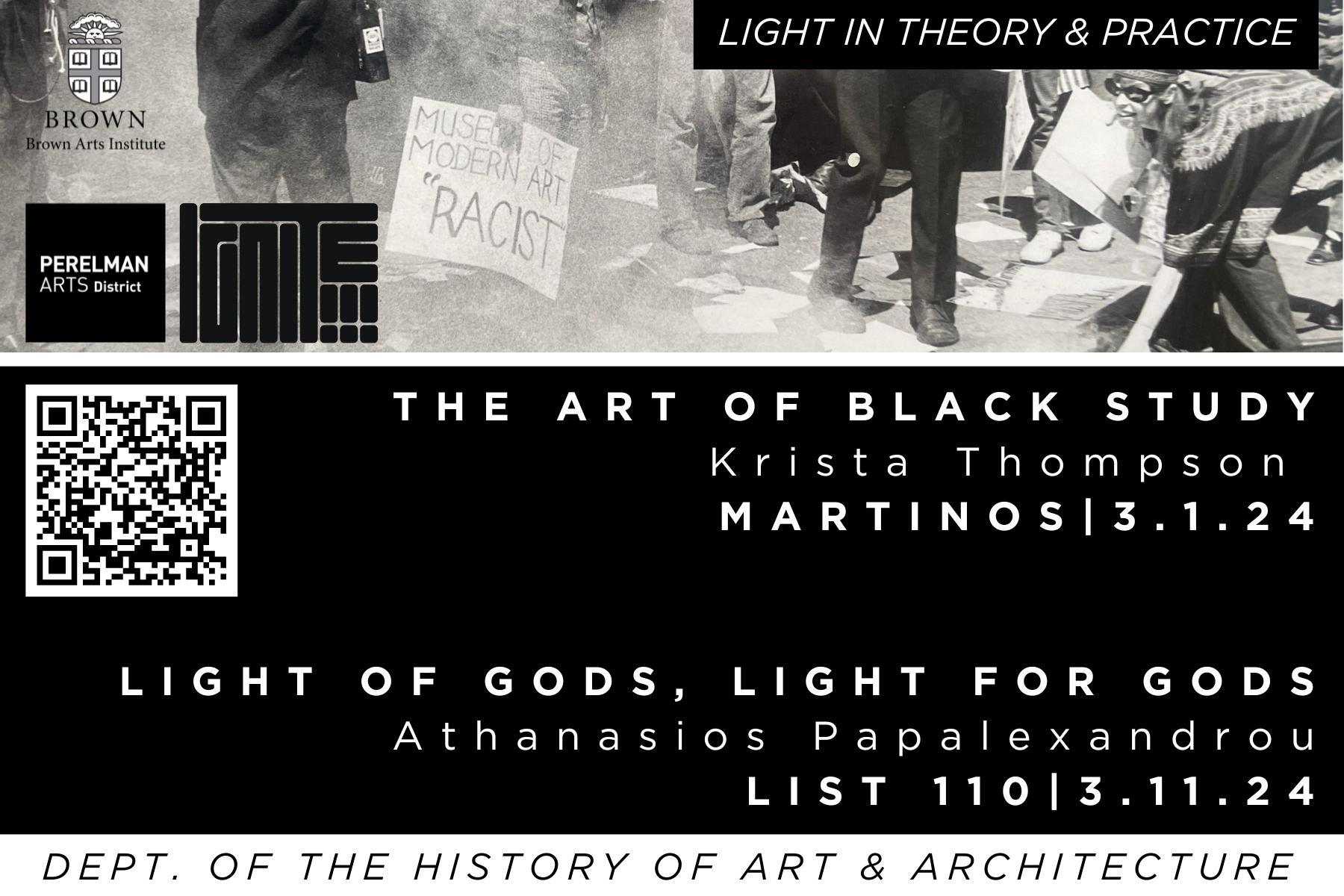
Pa G e 13 THE BROWN DAILY HERALD ARTS & CULTURE
LIFESTYLE
JeNNIFer CheN / heraLd
SCIENCE & RESEARCH
FACULTY SPOTLIGHT
Dean of Engineering Tejal Desai ’94 elected to National Academy of Engineering
Desai discusses career path, research following election to 2024 NAE class
BY CLAIRE SONG SENIOR STAFF WRITER
earlier this month, dean of engineering Tejal desai ’94 was among 114 engineers elected to the National academy of engineering’s class of 2024.
desai began as dean of the university’s school of engineering in september 2022, The herald previously reported. election to the academy is considered one of the highest distinctions in the field of engineering.
“The National academy of engineers is a group of engineers who I always looked up to that were amazing and made a tremendous impact in the field,” desai said in an interview with The herald.
desai started her academic career at brown, eventually earning a bachelor’s degree in biomedical engineering. during her time as an undergraduate, she said she received “various messages” that she should “not stay in the field.”
“I certainly struggled in my first year, trying to figure out how to do problem sets and how to work through these courses that I had never seen before,” she said, noting that internal doubt led her to question “whether I should stay in engineering or whether I should leave.”
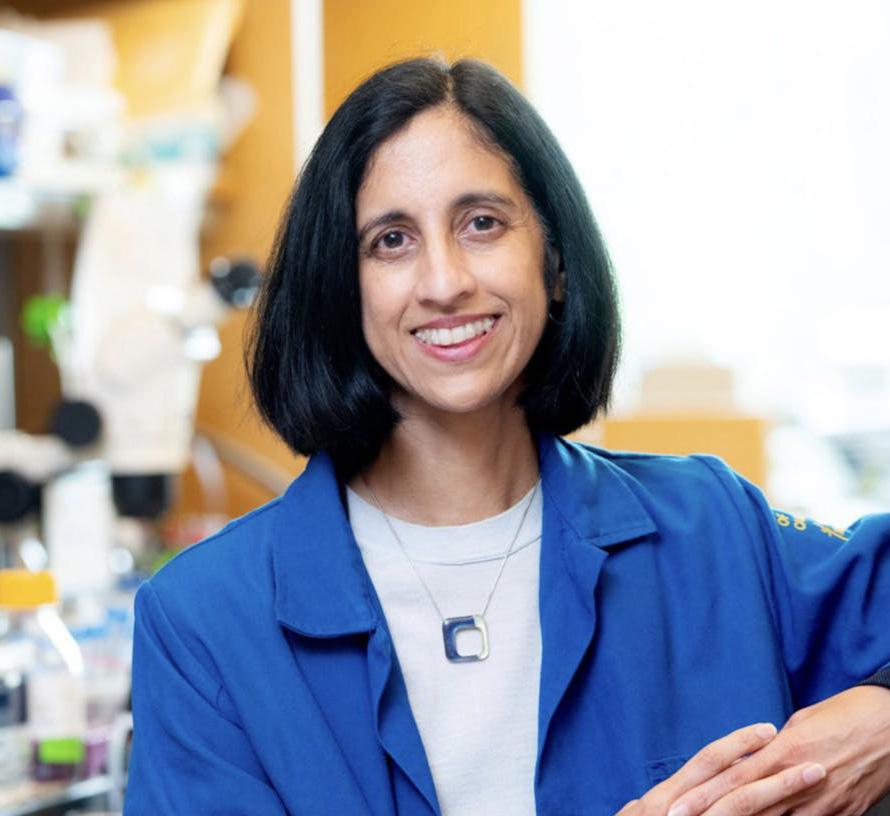
desai thanked her mentors who encouraged her to stay in the field, and she is grateful for those who helped “open up doors when doors weren’t open.” after her time at brown, desai pursued a Phd in bioengineering at the university of California at berkeley and the university of California at san Francisco, where she worked on small scale biomedical nanotechnology. her academic career continued as an assistant professor at the university of
Illinois at Chicago, helping develop both undergraduate and graduate programs in its then-new bioengineering department. soon, she found herself back on the west coast to help start the bioengineering department at uCsF, before returning to brown in 2022.
“I came to brown to make sure that I could make engineering at brown the best that it could be,” desai said, adding that she hoped to “make it a field that
embraces all perspectives, and encourage students who want to be an engineer to thrive in the field.”
The desai Lab at brown focuses on applying “microscale and nanoscale technologies” in order to “deliver medicines to target sites in the body and to enable the body to heal itself,” according to the lab website. a few members of desai’s lab talked to The herald about their experiences in the lab and working with desai.
audrey McCarthy Gs, a first year Phd student in desai’s lab, said that desai was the reason she had chosen brown for her doctoral career.
“she started asking me about my experiences in the lab work that I had done, but what really stuck out to me is that Tejal asked about my experience as a Wellesley undergraduate,” McCarthy said, noting that Wellesley is a women’s college. “That really struck a chord with me, because it told me that she is a woman for other women.”
McCarthy mentioned she had the opportunity to visit desai’s lab at uCsF prior to her move to brown. Talking to the graduate students in the lab gave her a “sense of the type of environment she wanted.”
“she is able to put together a group of people who can go nonstop all day doing animal work, then doing flow cytometry on the cells that they extracted from the animal work, and then go get hotpot at the end of the day,” McCarthy said. “That’s
Pandemic Journaling Project opens data to select researchers
Projects leaders weighed
BY BENJAMIN HERDEG CONTRIBUTING WRITER
since May 2020, the Pandemic Journaling Project has been collecting journal entries, audio samples and photographs from participants across the globe about life during the COVId-19 pandemic. On Feb. 15, Katherine Mason and sarah Willen, associate professors of archeology at brown and the university of Connecticut, respectively, made the project’s data available upon request for 25 years.
The data is now stored by the Qualitative r epository at niversity for researchers approved by


Mason, Willen and institutional review boards at the researchers’ universities.
both Mason and Willen noted that sebastian Karcher, associate director of the Qdr and assistant professor of political science at syracuse university, has been instrumental in managing the PJP’s archives.
Willen said she knew from the start that “the project … was designed for posterity” — a sentiment that aligned with Karcher and his team’s job at the Qdr , where he said they “think of the long term all the time.”
“It became clear very, very quickly that (the) Qdr would be an ideal partner in both ensuring accessibility to the material and ensuring that we would protect the confidentiality of our participants,” Willen added.
The issue of confidentiality was one of the key factors the PJP considered when deciding to share its data. “The one big piece is that if we wanted to make it immediately accessible to anyone we would have to go through and remove any potential identifi ers,” Willen said, adding that neither the project’s funding nor time allowed


The solution was to make data available to researchers upon request. This model will continue for 25 years. The data will only become publicly available in 2049, which Mason and Willen said will help ensure the confidentiality of participants in the years immediately following the pandemic.



espite declining attention on
-19, the project continues to study the pandemic’s effects, adapting its methodology as the pandemic develops and changes. For example, at the beginning of the project, Mason and Willen invited participants to contribute weekly, but during the project’s second phase, in May 2022, they collected samples every three months.

Willen explained that she and her colleagues designed this
what I’m excited for — to watch the lab grow and evolve over the next couple of years.”
Currently, McCarthy is focusing on how the lab can “put cells into polymer devices” and find shapes and materials that the cells can adhere to and survive on. she also mentioned she has undergone a lot of “personal growth” during her time at the desai lab.
Kareem ebeid, a postdoctoral research student, also talked to The herald about his experiences working on drug delivery in desai’s lab.
“she’s so busy, but she can meet with us every two to three weeks and discuss the fine details of our research,” ebeid said. e beid is working on gene delivery systems, which he started studying while pursuing a Phd at the university of Iowa. There, he formulated an idea for a potential new delivery system, but wanted to bring the idea to fruition after earning his degree. ebeid saw an opening for postdocs in desai’s lab after graduating from Iowa and pitched his idea to desai, which she received enthusiastically.
“she is very good at research,” he said. “I feel like those who are really good scientists and researchers are those who are very humble because it gives them this push to do more research.”
This article originally appeared online at browndailyherald.com on Feb. 25, 2024.

project as a form of “archival activism.” she hoped the project “would make it possible to write equitable histories, and just histories in which people wouldn’t be left out just because they don’t have strong voices in society or in the political sphere.”
a principal goal of this project is to better understand the role of community-based organizations during the pandemic and support these organizations’ future operations, according to Mason and Willen. To that end, the two have recently taken on subprojects under the PJP that spotlight specific communities, such as first-generation college students. Willen said students are invited to “reflect periodically on how the pandemic has affected them and continues to affect them.”
They also focused on immigrant communities in New york City, specifically south asian and Latinx women.



lthough Mason does not have specific hopes for future projects involving the project’s data, she wants their findings to be used to understand the experiences of ordinary people in an anomalous time. Willen similarly hopes that “people who have no personal memory of the pandemic will be able to connect with these materials.”
Karcher even suggested that the PJP could change the course of qualitative research for the future, saying it “is a really cool model for ambitious large, team-based qualitative research.”
Mason, Willen and Karcher all expressed their gratitude for working on the project, which will continue contributing to post-pandemic society through exhibitions. as anthropologists, we’ve created something that has helped people in a really disruptive, frightening, painful time,” Willen said. “It’s not something anthropologists often get to do.”


Pa G e 14 Thursday, February 29, 2024
COurTesy OF brOWN uNIVersIT y sChOOL OF eNGINeerING
SPOTLIGHT
Tejal Desai encouraged current engineering students to be resilient as they pursue a career in the field.
PROJECT
benefits,
before releasing data JuLIe WaNG / heraLd JeNNIFer CheN / heraLd
confidentiality
and opposing perspectives confront many of the most difficult issues facing society today.”
For some students, the invitation added to the political tension on campus surrounding the war between Israel and hamas.
The Graduate Labor Organization’s Palestinian solidarity Caucus began an email campaign on Feb. 16, challenging OIed’s decision to invite Greenblatt to speak. Community members sent 600 emails addressed to Carey- b utler and Wendy s chiller, a b rown professor of political science moderating the event.
“We don’t see how this event will do anything except create more animosity on campus, and we also disagree with the way that Jonathan Greenblatt has characterized Palestinian people and … anti-Zionist Jewish activists,” said devon epiphany Clifton Gs, the caucus’s organizing co-chair.
but the email template did not explicitly ask the OI ed to suspend the event, Clifton said. Instead, it expressed concerns about the effect of the talk on campus culture and the impact of an increased campus security presence on minority students. “We’re not even making a demand,” she added.
UNDERGRADUATE ACADEMICS
Zohar slav ’26, who attended the talk, wrote in an email to the herald that she was “excited” for Greenblatt’s visit but didn’t find that the event added to “the dialogue about the Israel-Palestine conflict on campus” as she felt that those with opposing views to Greenblatt’s paid little attention to his words.
a fter attending the talk, s lav said she felt that Greenblatt lent “intelligent insight on current antisemitism” and appeared “undeterred by the walkout.”
“It was also refreshing to hear such an authority figure say that anti-Zionism is antisemitic,” she wrote.
“a t b rown, like many students demonstrated, it is controversial to say such a thing, and that is exactly why it was important to bring a speaker like Jonathan Greenblatt here,” s lav wrote. “If there is no dialogue, there will be no solution.”
Other students questioned Greenblatt’s definition of antisemitism, including b eckett Warzer G s , a member of the caucus. “Greenblatt makes me, as an anti-Zionist Jew — and especially the Muslim, arab and Palestinian students on campus I am in solidarity with — more vulnerable to censorship and discrimination when he conflates just criticism of Israel with antisemitism,” Warzer wrote in an email to The herald.
d uring the event, some students held up signs reading “ d ivest Now” and “a nti-Zionism ≠ a ntisemitism’” before leaving the auditorium, The h erald previously reported. a fter the walkout, the students congregated on the Main Green, where they challenged his definition of antisemitism and shared a few brief remarks.
a riela rosenzweig ’24, a spokesperson for students involved in the walkout, wrote in a message to the h erald that students chose to leave the event because “the ad L, with its McCarthyite approach and — as described by its former employees — an ‘intellectually dishonest’ campaign against any criticism of Israel, goes against our community’s values and the university’s commitment to free intellectual exchange.” Greenblatt has sparked backlash within the ad L for his comments equating antisemitism and anti-Zionism, according to reporting from The Guardian. rosenzweig disagreed that the two are equivalent, adding that “the OIed talk last Thursday offered no opportunities for dialogue but rather a platform for Greenblatt to spread his dangerous rhetoric.”
“Greenblatt insulted and demeaned an entire class of Jews on the basis of their Jewishness and their politics,” Warzer said. “Walking out in protest of that was
the only appropriate response.”
Other community members saw the walkout as a refusal to enter into a dialogue with opposing ideas.
“I admire the adL and I admire Jonathan Greenblatt for being such a strong, outspoken advocate for the Jewish community and for communities beyond the Jewish community as well,” said rabbi Josh b olton, the executive director of brown rIsd hillel.
bolton pointed to the antisemitism that he and Jewish students have experienced on b rown’s campus recently, adding that while the Greenblatt talk was a step in the right direction, “no one invitation to Jonathan Greenblatt is going to undo the impact of the sheer number of anti-Israel, antisemitic presentations that will take place, and the things that are said in classrooms, by faculty and by students every day.”
a fter the event, b olton felt “tremendous support for the Jewish community in the administration,” he said. In an op-ed for The h erald published that same night, b olton wrote that “OI ed managed to do something that no other element of the u niversity had” by bringing together students with completely different views.
In his interview with The h erald, bolton expressed confidence in brown
students’ ability to find community and come together despite their differences. It is “not in character” for a brown student “to get up and leave when exposed to ideas that are different than their own,” he added.
he recalled seeing a student about to leave, turning around and sitting back down for the rest of the event.
Maya rackoff ’25 wrote in an email to The herald that despite identifying as “a firm Zionist,” she does not “approve of the way the anti-defamation League has pursued combating antisemitism since October 7th.”
The “rhetoric of the ad L has paradoxically benefited the anti-Israel cause at the expense of the pro-Israel cause,” rackoff wrote. “anti-Israel students don’t take Zionists seriously when the Zionists conflate every instance of Palestinian advocacy with antisemitism.” b ut rackoff expressed appreciation for OI ed ’s invitation.
Carey-butler stressed the role of higher education in exposing students to ideas that challenge their own and expressed her hope that the Greenblatt event contributed to viewpoint diversity on campus. but she added that she understood the pushback from students — student activism is part of “what makes brown, brown,” she said.
Sports, soccer management GISPs bring industry experts to campus
Courses explore topics in sports through case studies, guest speakers
BY JULIANNA CHANG UNIVERSITY NEWS EDITOR
This semester, the 48 students registered for two group independent study courses will have an opportunity that few other brown students ever get: a chance to introduce themselves to current and former executives in the Nba , NFL, MLb, WMLs and Premier League in the classroom.
GIsP 0001: “The Global sports Industry” and GIsP 0002: “Global Football Management,” developed by Charlie Pliner ’26 and Nikolas rohrmann ’26, explore “different aspects of (soccer and sports management) all over the world through case studies and guest speakers,” Pliner told The herald. GIsPs, which have risen in popularity in recent years, allow students to create a new credit-bearing course alongside a faculty sponsor.
In both courses, a typical class session features at least one guest speaker — often a brown alum — who answers students’ questions about their experiences in the sports industry. In the first few weeks, students in “The Global sports Industry” spoke to brad stevens, who serves as the boston Celtics’ president of basketball operations, and Celtics senior consultant Jeff Van Gundy.
In the next few weeks, students in Global Football Management will hear from sports executives including Julie uhrman, co-founder and president of angel City FC; Jesse Marsch, who is a former Major League soccer player and most recently the manager of Leeds united; and Phil Lynch, the CeO of digital experiences at Manchester united.
Thano Chaltas ’87 P’24, a professor in the school of engineering and one of two faculty sponsors for the two sports-related GIsPs, said the courses “are a great way for students to learn not only about sports,

but also how all of these (business and entrepreneurship) concepts apply to sports and other industries,” he told The herald.
Professor emeritus of engineering barrett hazeltine is the other faculty sponsor for the courses. “sports can be a vehicle for really understanding how people and organizations behave, both objectively and quantitatively,” hazeltine said.
rohrmann and Pliner, two international students from europe, created the course because they felt that the field of sports management was missing from brown’s current course offerings, they told The herald.
“There is so much research and (so many) case studies about sports that it’s become such a big industry that people need to take it seriously” in academic set-
tings, Pliner said.
Pliner — who previously interned for Chelsea Football Club and currently works as a consultant for FIFa’s Professional Football relations and development — hopes that by bringing his hands-on industry experience to campus, he can help “lift the veil on what actually happens in sports,” he said.
In May, Pliner and r ohrmann approached Vice President for athletics and recreation M. Grace Calhoun ’92 Phd P’26 P’26 with their idea. Calhoun was “proud and excited to support Charlie and Niko” as they developed the GIsPs last fall, she wrote in an email to The herald.
In december, Pliner and rohrmann advertised their course to student athletes and students from eNGN 0090: “Man-
agement of Industrial and Nonprofit Organizations,” a popular entrepreneurship course co-taught by Chaltas and hazeltine. Prospective students filled out an application indicating their desire to take either one of the two courses.
When reviewing applications, Pliner and rohrmann were looking for students “who had gone the extra mile and shown that they either played a sport at a high level, worked a job in sports somehow or had a unique story to do with sports,” Pliner said.
The two received more than 130 applications but could only accept a total of 48 students across the two courses, according to Pliner.
Now, enrolled students are learning about player development, club management and other contemporary issues related to the sports industry.
In the coming weeks, students in Global Football Management will discuss the agent business — how player and coach employment deals are negotiated and made — as well as societal and gender issues in soccer, stadium development and digital marketing.
students in the sports management course recently heard from retired tennis player Todd Martin, who reached a career-high ranking of fourth in the world in men’s singles in 1999.
d iscussing his 14-year professional playing career and subsequent coaching career, Martin — who coached Olympic silver Medalist Mardy Fish and current No. 1 men’s singles player Novak djokovic — told the students that the highlight of his playing career was when he realized that it would become a career, not just a moment.
“education is core, so having an opportunity to come and speak to the students here was an exciting opportunity for me,” Martin told The herald.
Martin appreciated that the course is “centered on the real-world experiences of a variety of relatively unique human beings,” he said.
Over the next few weeks, students in The Global sports Industry will hear from
Karen sturges, the CFO of the Los angeles 2028 Olympics, and hiroshi Mikitani, the founder and CeO of rakuten, a Japanese technology company.
Throughout the remainder of the semester, Pliner and rohrmann also plan to host current and former executives of the Oakland athletics, san Jose earthquakes, san diego Padres, New york Jets, boston Celtics and boston red sox, according to rohrmann.
Justin blake ’27, who is currently enrolled in the Global Football Management, has “never had the opportunity to really explore football beyond the sporting or fan aspects,” he said.
blake, an avid soccer fan and player since age six, said he believes that the GIsP is “a chance to engage with material and people you wouldn’t normally engage with.”
“It’s nice when people’s practical experience can be used in conjunction with what we’re learning,” blake added.
Kelly dolce ’26, a member of the women’s swimming and diving team, is currently enrolled in The Global sports Industry. dolce, who plans to pursue a career in sports, hopes that the class will help her gain a better understanding of the industry and make connections with like-minded peers and professionals.
Calhoun hopes that the courses “might inspire some of our students to follow a career path that I have personally found to be truly rewarding in so many ways,” she wrote.
These courses are “truly the best of the Open Curriculum,” Chaltas said. “It’s truly student-directed, student-driven, faculty-supported learning.”
Correction: a previous version of this article misstated the titles of Julie uhrman and Jesse Marsch. Julie uhrman currently serves as president of angel City FC and Jesse Marsch no longer manages Leeds united. The herald regrets the errors.
This article originally appeared online at browndailyherald.com on Feb. 25, 2024.
Pa G e 15 THE BROWN DAILY HERALD UNIVERSITY NEWS
COurTesy OF CharLIe PLINer ’26.
The GISP, created by Charlie Pliner ’26 and Nikolas Rohrmann ’26, recently heard from retired tennis player Todd Martin.
ADL FROM PAGE 15
UNDERGRADUATE ACADEMICS
Sex on the syllabus: Professors, students discuss intimacy-related courses at Brown
Students explore sex, love, desire in PHIL 1576, ENGL 0201F
BY LEAH KORITZ SENIOR STAFF WRITER
Let’s talk about sex, baby. Let’s talk about … Pornography?
No, this isn’t just a reference to saltN-Pepa’s hit single, but an apt descriptor of PhIL 1576: “Pornography,” a popular philosophy class at the university.
This semester, interested students had their pick of several classes exploring sex, intimacy and love, including PhIL 1576 and eNGL 0201F: “sex, sin, sonnets: The Poetry of Love and desire.” The herald spoke to the professors teaching these two courses and their students about how these topics are addressed in the classroom.
Philosophy and Linguistics Professor richard Kimberly heck, who developed and teaches PhIL 1576, offered the course for the first time two years ago. When heck taught a unit on pornography in PhIL 1490: “Philosophy of sex” in 2020, they realized that there was too much content to cover in just one unit. They then developed a syllabus for a new pornography-centered course.
according to the course syllabus, PhIL 1576 attempts to answer one driving question: If “pornography has become a form of sex education, what kinds of lessons does it teach?”
The course will also investigate whether pornographic media can be considered art or “whether pornographic media even
ADMISSIONS

admit of serious analysis,” the syllabus reads.
Throughout the semester, students in the course will answer these questions by exploring past pornography controversies, the differences between feminist and misogynistic pornography and the aesthetics of pornography. In addition to pornographic films, the course assigns readings by social activist Gloria steinem, author and activist ellen Willis and legal scholar Catharine MacKinnon.
PhIL 1576 “is a rigorous philosophy course with a lot of long philosophy papers,” teaching assistant Kate Kuli ’25 said. “It’s not just watching porn.”
In previous years, the course’s enrollment was largely dominated by women, which heck explained was unusual for a philosophy class. but this year, “there are a lot more perspectives represented” in
class discussions, heck said.
While few peer institutions offer pornography-related courses, heck believes it is an important topic to study in academic settings because it “has just become a part of the fabric of people’s lives in a way that it wasn’t when I was growing up.”
It is “important to really think critically and seriously” about pornography, heck said.
heck expressed that pornography’s negative reputation is largely influenced by the academic community’s “warped perceptions” of the industry. Many institutions teach about pornography to discourage students from engaging with it, rather than analyzing it from a neutral lens, they said.
“I make it quite clear to my students that we’re not here to be judgmental,” heck said. “We’re not here to say, ‘Pornography is evil.’ Maybe it is, maybe it’s not — I’m here
to help them think this through.”
Kuli added that heck “creates a super safe space for students to talk about these things in a way that (includes) both very rigorous debate (and is) also very respectful.”
Jared dunn ’24, a student in PhIL 1576, registered for the course because it was unlike any other he had taken in the past. In the course, dunn hopes to gain a deeper understanding of how pornography influences people’s perspectives on sex.
dunn emphasized that the class is not for everyone, as discussing pornography in an academic context might make some students uncomfortable. but dunn has enjoyed the course so far and “will be thinking about it even after it’s over,” he said, adding that he discusses class concepts and materials with peers long after the class ends.
although Kuli is the course’s Ta , she is also taking the course for a grade. “I am a student at brown — when else in my life am I going to take a class about porn?” she said.
Kuli explained that pornography can reinforce “problematic” societal and sexual norms that can influence intimacy. “deconstructing that (idea) and understanding it is the first step to building a better future on an individual scale — and even on a structural scale, too,” she said, adding that the course cultivates hope for healthier discussions about and depictions of sex and intimacy.
eNGL 0201F: “sex, sin, sonnets: The Poetry of Love and desire” is taught by benjamin salt Gs as a part of his Phd program. Poetry is “such an interesting vehicle for expressing desire,” salt said,
highlighting the role of rhetoric, metaphors and figurative language in writing about sexuality.
eNGL 0201F explores how poets like shakespeare, sylvia Plath, W.b yeats and G.M. hopkins think and write about “the body, shame, excess, lust, pleasure/pain and ecstasy,” according to the syllabus.
“Our conceptions of love and desire might be really different (now) than what they were in the 20th century, the 18th century and even (during) shakespeare’s career,” salt said. “Notions of what love might be — how it’s expressed, who it’s between, sexual categories and gender categories — all shift” over time.
“ s ex, love and desire are intrinsic facets of the human experience, yet they are frequently treated as shameful taboos,” wrote a mina Fayaz ’26, a student currently registered for s alt’s seminar, in a message to The herald, “While the course initially drew me in due to (its) comprehensive focus on poetry, I have come to find the most value in the candid discussions about sex.”
Fayaz — who said she grew up in a conservative household — wrote that e NGL 0201F has made her “less ashamed (of) engaging in conversations about this integral aspect of the human experience.”
Fayaz appreciates salt’s “kind, supportive personality” and inclusion of diverse poets. “In a class about sex, which is fundamentally personal and colored by the diverse identities we all embody, affirming all perspectives is important,” she wrote. “Classroom discussions about sex foster empathy.”
Brown community members reflect on video introduction in admissions
Video introductions replaced alum interviews over three years ago
BY TALIA LEVINE SENIOR STAFF WRITER
since the admissions cycle for the class of 2023, brown has offered prospective students the opportunity to submit an optional two-minute video introduction in lieu of the in-person interviews colleges have traditionally conducted during the undergraduate admission process.
For the first few years of this program, applicants could choose between a video introduction or an alum interview. starting in 2020, due to the COVId-19 pandemic, interviews were suspended and eventually eliminated.
“The video introduction offers us compelling insights into our applicants,” said Logan Powell, the associate provost for enrollment and dean of undergraduate admission, while reflecting on this year’s applicants. “Through their voices and their stories, we are able to understand their journeys, goals and dreams.”
Video introductions were first offered during the 2018-19 application cycle because the number of applicants requesting interviews surpassed the number of interviews alums could conduct, The herald previously reported.
In 2020, alum interviews were suspended.
Powell then told The herald that in the 201920 application cycle, over 8,000 applicants asked for an interview but did not receive one. he also said that alums expressed frustration at their interviewees not eventually being
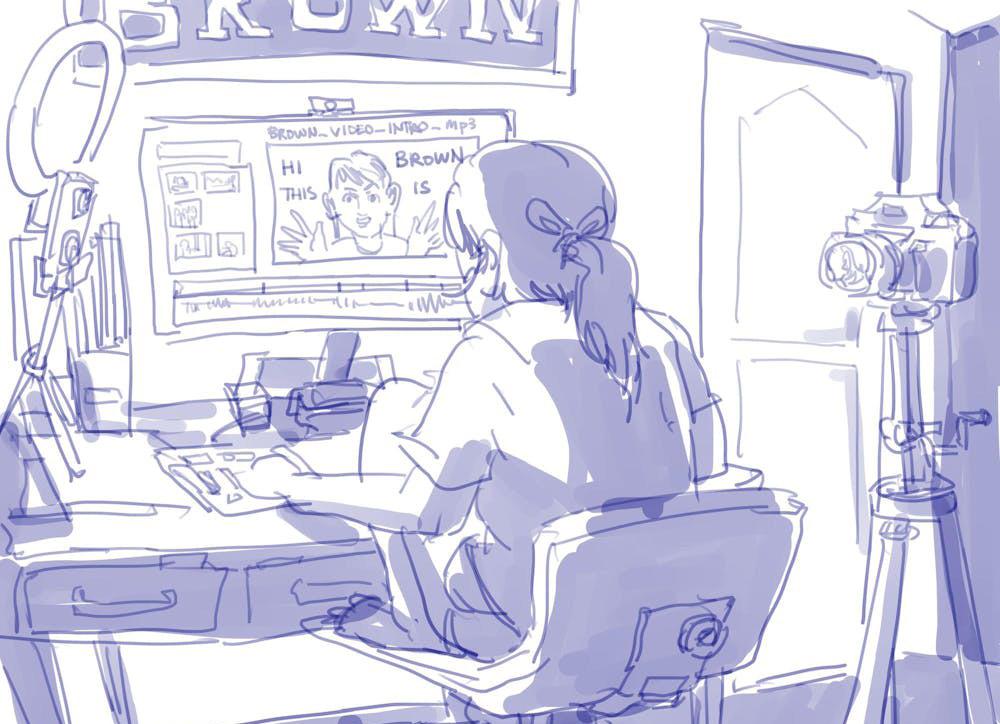
admitted, a factor in eventually deciding to eliminate the interview program. according to a poll of the class of 2027 that The herald conducted last summer, 84% of students chose to submit video introductions. holt daniels ’27 was among a number of brown students to post his video on youTube, where it has been viewed more than 24,000 times. daniels’s video starts with a spoken introduction, followed by his rendition of adrianne Lenker’s “abyss kiss” overlaid on a montage of him playing guitar.
“While singing a little song and talking
about what brings me joy may not sound very serious, I think it ended up going a long way because these things were further showcased later in my application,” daniels said. In one of his application essays, he wrote about his “relationship to adrianne Lenker’s music and how I use her calming songs as a coping mechanism to relax when I have a lot going on.”
“I hoped the admissions officer would experience the relaxation induced by the Lenker song I sang to them and be able to understand … why her music means so much to me,” he added.
Thomas Medlin ’27 said he feels that his video introduction “added authenticity” to his application. Medlin’s video follows him throughout his day as he donates blood, goes for a run, plays piano and builds Legos. Medlin, like daniels, chose to upload his introduction to youTube. “I really didn’t expect it to get as many views as it did,” he said. The video has since received 12,000 views. he also used it as an opportunity to advise prospective applicants: “I left a pinned comment encouraging people to be themselves rather than attempt to make a blockbuster
film that felt like bragging or an application summary.”
eric sherman, a college admissions counselor at IvyWise, is a “strong proponent” of the video introduction when students are given the option during applications. Washington university in st. Louis, the university of Chicago and bowdoin College are among the other institutions offering applicants the opportunity to submit such testimonials.
When he advises students on their videos, sherman encourages students to “be dynamic” and bring the admissions officers “into your world.”
according to david Chy ’16, interviews used to give alums “a fairly low-commitment, low-intensity way to stay involved” with the university. Chy, who first started doing alum interviews after graduating and soon became the admission office’s regional chair for New england interviews, added that he was excited by the prospect of connecting with applicants.
The interviews provided an applicant with the opportunity to “tell their own story in their own words, live and in the flesh,” he said. but now that interviews are no longer offered, alums can connect with students after they are admitted, Chy added. as a member of brown’s asian american Pacific Islander alumni affinity Group, he now “(reaches) out to admitted asian american Pacific Islander students to encourage them to matriculate and/or answer any questions they might have about making a decision to attend brown.”
This article originally appeared online at browndailyherald.com on Feb. 26, 2024.
Pa G e 16 Thursday, February 29, 2024 UNIVERSITY NEWS
aVery GuO / heraLd
rhea rasQuINha / heraLd


























































